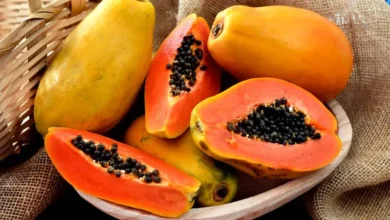Foods You’ll Never Eat Again After You Know The Ingredients
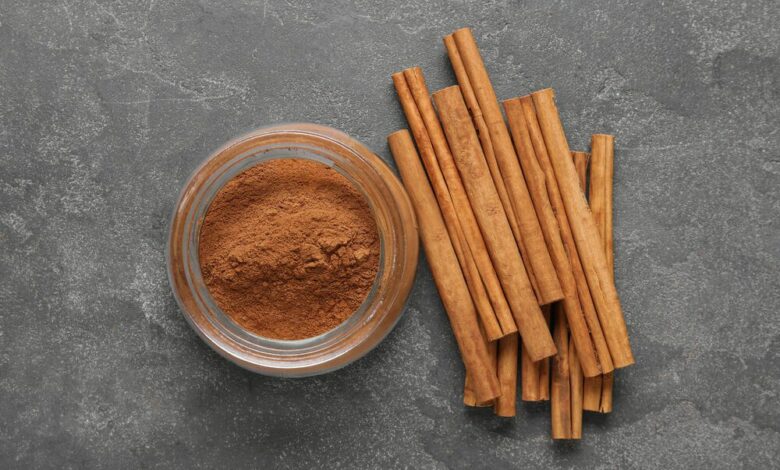
1. Cheese In A Can
Company: Kraft and others
Market Share: $64.68 billion total cheese snacks market*
Ingredient: Curdled milk
There’s probably a reason why cheese in a can isn’t really popular in any other country besides America. It’s just too gross to think about for most people, even if they don’t know what’s really in it. It might go without saying, but you’re not going to get a lot of nutrition from this cheese.
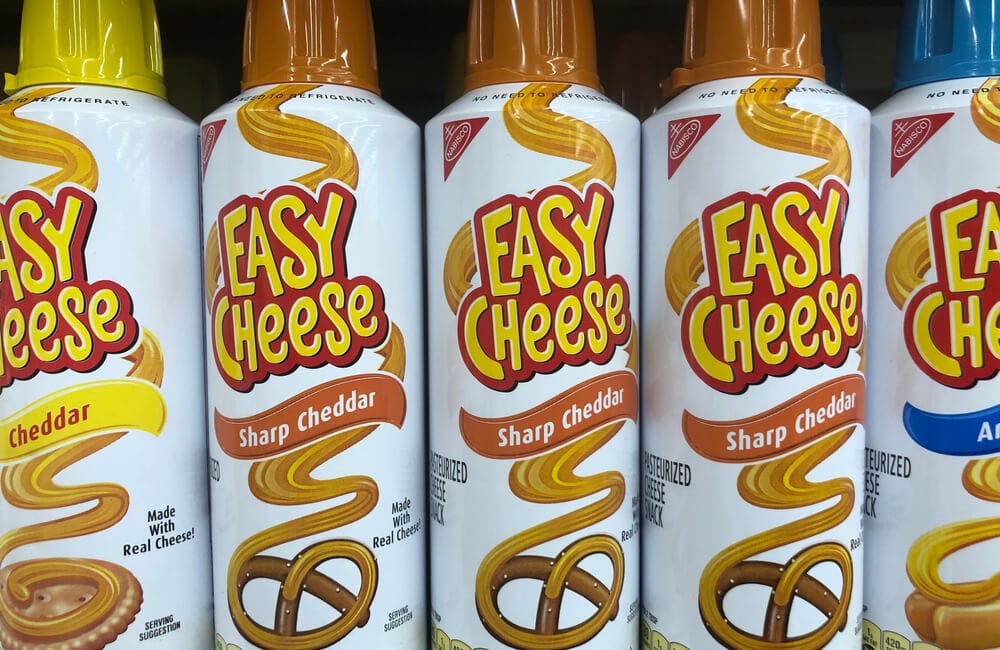 Cheese in a Can @melissamn / Shutterstock.com
Cheese in a Can @melissamn / Shutterstock.comThese cans are pumped full of weird ingredients, including whey – aka curdled milk. It’s cheaper than actual cheese and presumably does better in a can, so it’s what a lot of companies use to bulk out the product. Bonus ingredient: sodium phosphate which is typically used to relieve constipation.
2. Sausages
Company: Various
Market Share: $7 billion*
Ingredient: Pigskin
If you’re used to eating sausages then you probably don’t mind that you’re eating pig, but there’s something else you should think about too, other than the filling. Sausage casings themselves aren’t all that great.
 Sausages @Valentina_G / Shutterstock.com
Sausages @Valentina_G / Shutterstock.comOn a good day, you’ll find a brand that uses pig skin as casing. On a bad day, you might find that the casing is actually made out of cellulose, or even a thin plastic. It’s hit or miss, and frankly, this isn’t one you want to miss. When it comes to meat, cheap really isn’t worth it.
3. Caviar
Company: Various overseas shipments
Market Share: $496.3 million by 2025*
Ingredient: Borax
It doesn’t take a scientist to know that Borax shouldn’t be consumed. Even the FDA knows it, which is why it’s banned from a lot of foods made and sold in America. That being said, there are some things that sneak their way through to shelves, including caviar.
 Caviar ©BT Image / Shutterstock.com / Shutterstock.com
Caviar ©BT Image / Shutterstock.com / Shutterstock.comA lot of brands across the world use Borax to preserve the fish eggs, although it’s listed as E285 on the ingredients label. Next time you decide to splash the cash on something fancy for your dinner party, take a look at where it comes from and see if there’s anything unsavory lurking inside.
4. Canned Pineapple
Company: Bel Monte and others
Market Share: $9.95 billion total canned fruits market*
Ingredient: More sugar, more calories, mold
Canned pineapple is great for when you’re in a pinch, but if you always thought it was the same as the fresh variety, you’re in for a shock. Raw pineapple is great, but canned pineapple is higher in calories, higher in sugar, and generally not that good for you.
 Canned Pineapple ©calimedia / Shutterstock.com
Canned Pineapple ©calimedia / Shutterstock.comEven if you get it canned in its own juices, you can’t beat the raw kind when it comes to nutrition. If you’re not particularly bothered by sugar or calorie content, then it might not put you off, but be under no illusions – canned isn’t king when it comes to this fruit. What’s more, cans can contain up to 20% mold.
5. Citrus Flavored Sodas
Company: Mountain Dew and others
Market Share: 7% of total soda market* (Mountain Dew)
Ingredient: Yellow 5
A lot of soda companies use food dye and other colarants to make their product look more appealing, especially if it’s a citrus-flavored drink. There’s one ingredient called Yellow 5 that’s supposed to be quite a bright yellow, but is that all it is? Does it do anything else?
 Citrus Flavored Sodas ©hmzphotostory / Shutterstock.com
Citrus Flavored Sodas ©hmzphotostory / Shutterstock.comA while ago, rumors started circulating that Yellow 5 could actually shrink testicles and lower sperm counts. While this was proven to be false, it certainly wasn’t a good look for those using it in their products, and as they say, mud sticks!
6. Margarine
Company: Various
Market Share: $38.41 billion by 2027*
Ingredient: One molecule away from being plastic
Butter is an amazing substance that most of us really love. On toast, in cakes, basted over a chicken, you just can’t substitute the real thing. Although, some have tried. Margarine was first invented as turkey food, but when the turkeys had enough of it scientists found another use for it.
 Margarine ©Ian Francis / Shutterstock.com
Margarine ©Ian Francis / Shutterstock.comSome internet sleuths have claimed that margarine, as a man-made substance, is actually just one molecule away from being plastic. Whether this is true or not is up for debate, but it’s definitely not appetizing when you think about spreading it on your muffin, is it?
7. Instant Powder Soup
Company: Campbell’s and others
Market Share: $21 billion by 2027* (Total Soup Market)
Ingredient: Sand
Grabbing a packet of instant soup for lunch can seem like an easy fix when you’re caught out, but don’t be fooled. That gritty texture you’re chugging down isn’t just seasoning that hasn’t dissolved well. Apparently, it’s sand.
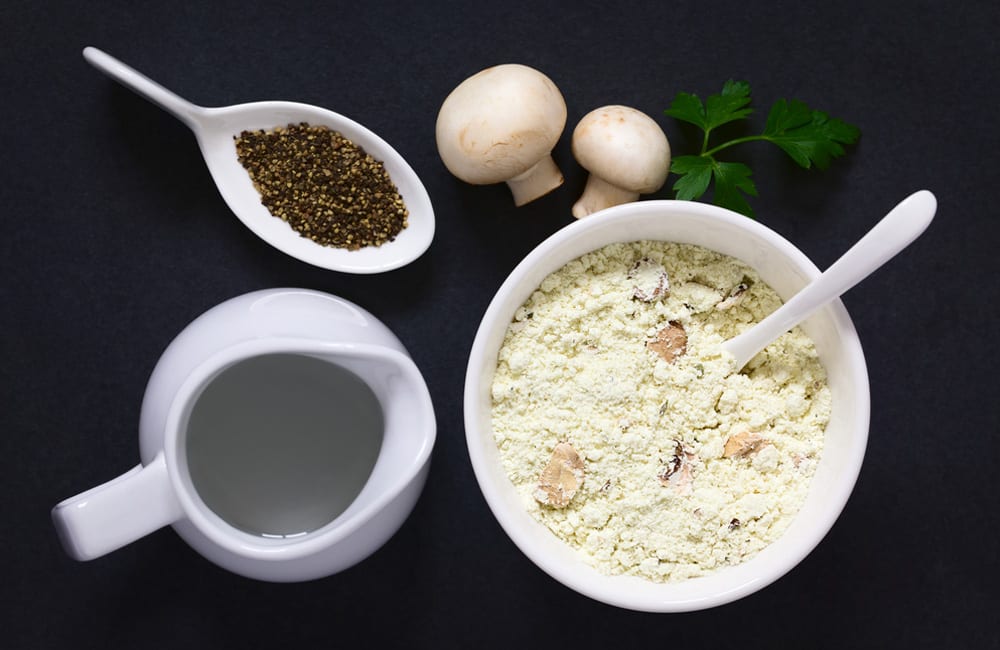 Instant Powder Soup ©Ildi Papp / Shutterstock.com
Instant Powder Soup ©Ildi Papp / Shutterstock.comSand is often thrown into the mix to stop it from clumping together. It’s not a huge amount, but it’s still odd to think that the FDA approved this as safe to consume, especially if you eat it every day. This could be another reason to cook fresh every day instead of going for a quick fix, but let’s face it, who has time for that?
8. Salad Dressing
Company: Various
Market Share: $23.5 billion by 2026*
Ingredient: Paint chemicals
There’s no better way to elevate your salad game than by buying a good dressing, but all may not be as it seems. Some salad dressings actually have titanium dioxide in them, which is actually a chemical found in paints and sunscreens to give them a whiter sheen.
 Salad Dressing @Chris LayKK / Shutterstock.com
Salad Dressing @Chris LayKK / Shutterstock.comThat’s not the only secret lurking beneath the appealing exterior, either. Propylene glycol can also be found in it. If you haven’t heard of it before, that’s because it’s antifreeze. It’s not something you want unless you’re trying to get your car on the road in the middle of winter, so why would you eat it? It’s a thickening agent, apparently.
9. Microwave Popcorn
Company: Various
Market Share: $5.2 billion total popcorn market*
Ingredient: Non-stick chemicals
There’s nothing better than popping some microwavable popcorn and settling down to watch a movie. It’s quick, it smells great, and it’s not messy. However, there’s a catch. The inside of popcorn bags is usually coated with nonstick to stop the kernels from getting attached to the bag.
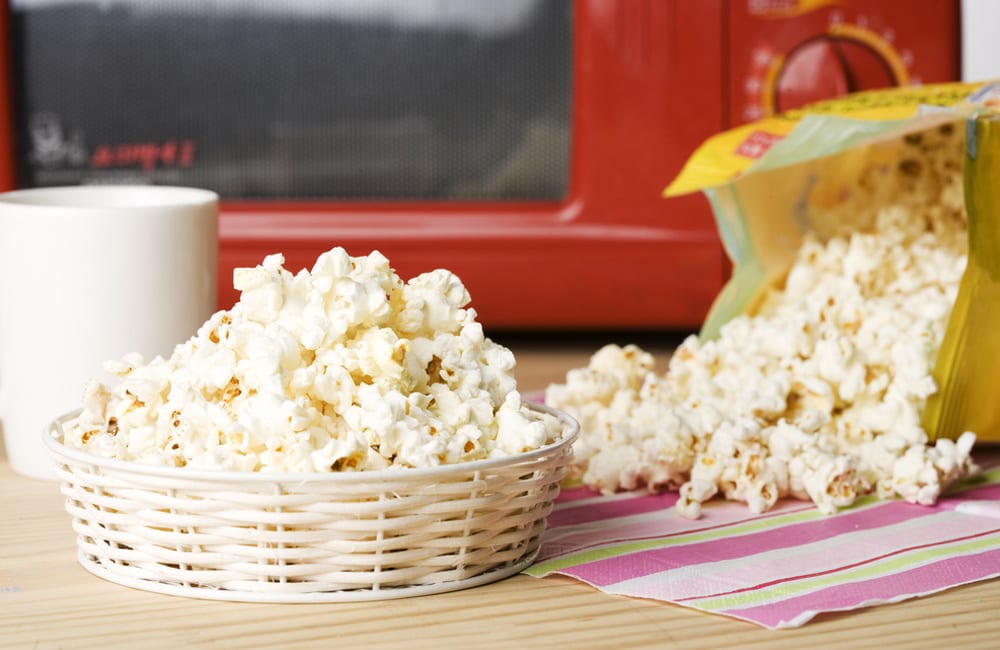 Microwavable Popcorn ©st.noon / Shutterstock.com
Microwavable Popcorn ©st.noon / Shutterstock.comIt works great, but nonstick coatings have been connected to health problems for decades now, so it might be time to turn to the stove instead of the microwave. No one wants to wake up one day and realize their popcorn habit gave them a serious illness, do they? While you’re at it, ditch the nonstick pans, too.
10. Donuts
Company: Various
Market Share: $8.9 billion by 2023*
Ingredient: Carnauba wax
Everyone loves a happy, round donut, don’t they? Whether you’re into a jelly one, like them more exciting, or just love a bear claw, there’s something for everyone. Have you ever wondered how donuts get their lovely, glossy finish?
 Doughnuts ©Fascinadora / Shutterstock.com
Doughnuts ©Fascinadora / Shutterstock.comIt’s not true for all companies, but some use something called carnauba wax. It might sound harmless, but it’s the same ingredient that’s used in shoe polish, cosmetics, and even floor cleaner. It’s supposedly safe to consume, but it’s still a little bit off-putting, isn’t it? Next time, we’ll go for plain.
11. Packaged Meat
Company: Walmart and others
Market Share: $320 billion*
Ingredient: Carbon monoxide
Busy families often pick up a ton of packaged meat during shopping trips. A pound of ground beef can make a couple of meals and it’s a cost-effective way to make sure everyone gets fed. However, even if you buy top-quality meat, you could be consuming something more than protein.
 Packaged Meat ©Sergey Ryzhov / Shutterstock.com
Packaged Meat ©Sergey Ryzhov / Shutterstock.comMeat plants actually use carbon monoxide as it helps meat keep that red color that it wouldn’t usually after being out in the air. Granted, it’s a small amount and doesn’t impact the taste, but it’s actually a double-edged sword. Even if the meat has gone bad, it will keep the same color, so you might want to be extra careful when browsing the shelves at stores like Costco in the future.
12. Cake
Company: Various
Market Share: $44.05 billion*
Ingredient: Human hair
Cake should be made up of flour, flavoring, and tons of icing if you ask us, but mass production means that a few other ingredients end up thrown in the mix. Sadly for all the cake lovers out there, a lot of cakes have a compound called L-cysteine in them. This is something derived from human hair or duck feathers.
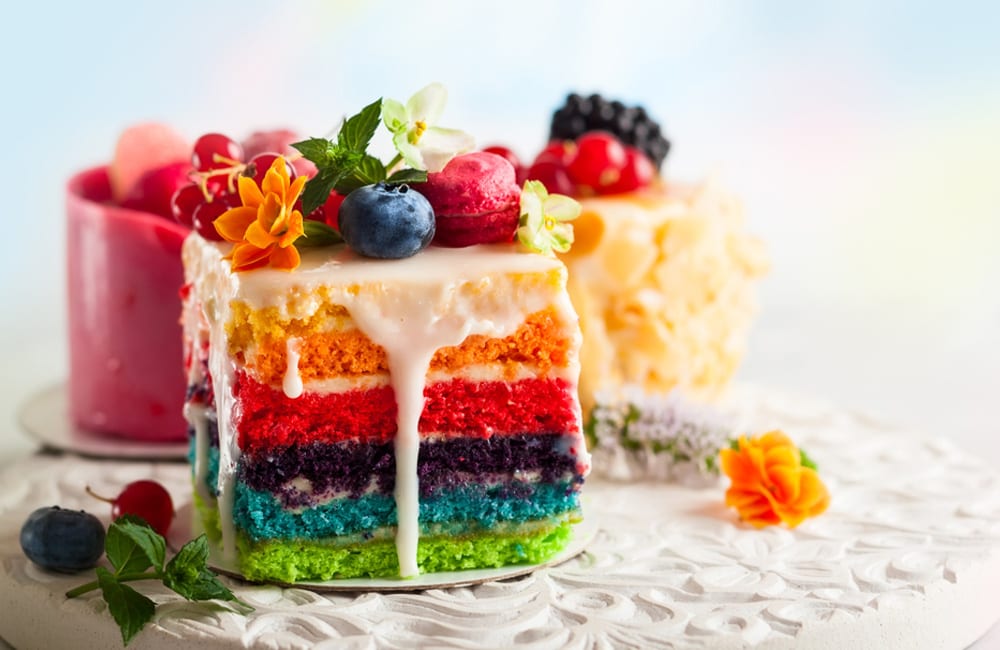 Cake ©Kolpakova Svetlana / Shutterstock.com
Cake ©Kolpakova Svetlana / Shutterstock.comIt sounds disgusting and really, it is, but it’s supposed to add flavor to the bake. We don’t fully understand why either, but we can all agree that when we go for a slice, we certainly don’t want human hair on our plates. Little did we know it’s already in a whole bunch of common foods as well.
13. Chicken Nuggets
Company: McDonalds and others
Market Share: $1.1 billion of frozen nuggets sold yearly*
Ingredient: TBHQ
You don’t have to be Martha Stewart to appreciate that processed fast food isn’t exactly good for you. But, that being said, most of us at least expect it to be safe to consume. That isn’t always how things go, though. McDonald’s chicken nuggets, for instance, have a chemical called TBHQ in them.
 Chicken Nuggets ©Olga Miltsova / Shutterstock.com
Chicken Nuggets ©Olga Miltsova / Shutterstock.comThis actually comes from the oil that they’re cooked in, as it stops it from going off. This chemical is an antioxidant, but it’s not one of the good ones. The FDA says a little bit here and there is okay, but it’s not safe in large doses.
14. Cereal
Company: Various
Market Share: $95.9 billion by 2030*
Ingredient: BHT
Preservatives are common in food, we all know that. That’s how companies are able to make such huge quantities of food and ship them across the world. That doesn’t mean we expect the food to have weird ingredients that are questionable, though.
 Cereal ©ANTHONY PAZ / Shutterstock.com
Cereal ©ANTHONY PAZ / Shutterstock.comIn 2015, General Mills opted to remove an antioxidant ingredient, BHT, from its products when there were claims about the safety of the synthetic substance. Just like TBHQ, BHT is a substance typically used to stop frying oil from going bad. Who wants to wake up to a bowl of that?
15. Oregano
Company: Various
Market Share: $17.6 billion by 2029*
Ingredient: Aphids and spider mites
Oregano can add some much-needed flavor to a meal, but if you pick it straight from the garden you might want to make sure you thoroughly wash it…then wash it again. You might love oregano, but so do aphids and spider mites.
 Oregano ©HandmadePictures / Shutterstock.com
Oregano ©HandmadePictures / Shutterstock.comThose little guys can’t get enough of the green stuff, so just make sure you don’t have any lingering on your leaves when you chop them up to garnish your next dish. You don’t want to serve up something with a side of insects, no matter how much you don’t like the person you’re giving it to.
16. Shrimps
Company: Imported brands
Market Share: $28.45 billion*
Ingredient: Cockroaches, pesticides, chemicals, poop
There’s nothing finer than a lovely shrimp cocktail on a summer’s day, but do you know where the shrimp has come from? To the horror of many seafood lovers, shrimps that are imported have been home to many nasties over the years.
 Shrimps ©koss13 / Shutterstock.com
Shrimps ©koss13 / Shutterstock.comSome have been sprayed with harsh pesticides, banned chemicals, and some have even had cockroaches found in them. None of these things are what you want to consume and bring into your body, so when you buy shrimp, read the packet and get it from a trusted source!
17. Peanut Butter
Company: Jif and others
Market Share: $7.89 billion by 2030*
Ingredient: Rodent hair
Peanut butter is one of the best things to come out of the modern world, but rodents might not think so. They certainly wouldn’t eat it themselves, because it can have rodent hair in it. One rodent hair per 100 grams is the limit according to the FDA.
 Peanut Butter ©inewsfoto / Shutterstock.com
Peanut Butter ©inewsfoto / Shutterstock.comThere are plenty of people that would argue one rodent hair is one hair too many, but it’s seemingly not that big of a deal. Instead of eliminating them entirely, someone in the world decided it would be better to just allow a few stray ones here and there.
18. Cinnamon
Company: Various
Market Share: $1.28 billion by 2028*
Ingredient: Animal feces
Cinnamon basically embodies the spirit of Christmas, but it’s great to have all year round. The trouble is, the FDA actually doesn’t care if there’s animal poo in it at all. A tiny amount of excrement is A-okay by their standards.
 Cinnamon ©Indian Food Images / Shutterstock.com
Cinnamon ©Indian Food Images / Shutterstock.comSo, next time you want to give mulled cider more of a kick by adding some of the spice in, just remember you might be getting even more bang for your buck. Forget about a lump of coal, someone’s getting a different kind of lump with their glass for Christmas this year.
19. Fried Chicken
Company: KFC, Popeyes, and more
Market Share: $9.85 billion by 2030*
Ingredient: Saturated/Trans Fats
The “fried” in the title should be an indication of where we’re going with this. Let’s be honest—fried food tastes great. Alas, the thing that makes it taste great (frying in oil) is the reason that fried food is a treat best enjoyed on a rare occasion. Fried chicken, because of its cooking process, is high in saturated and trans fats.
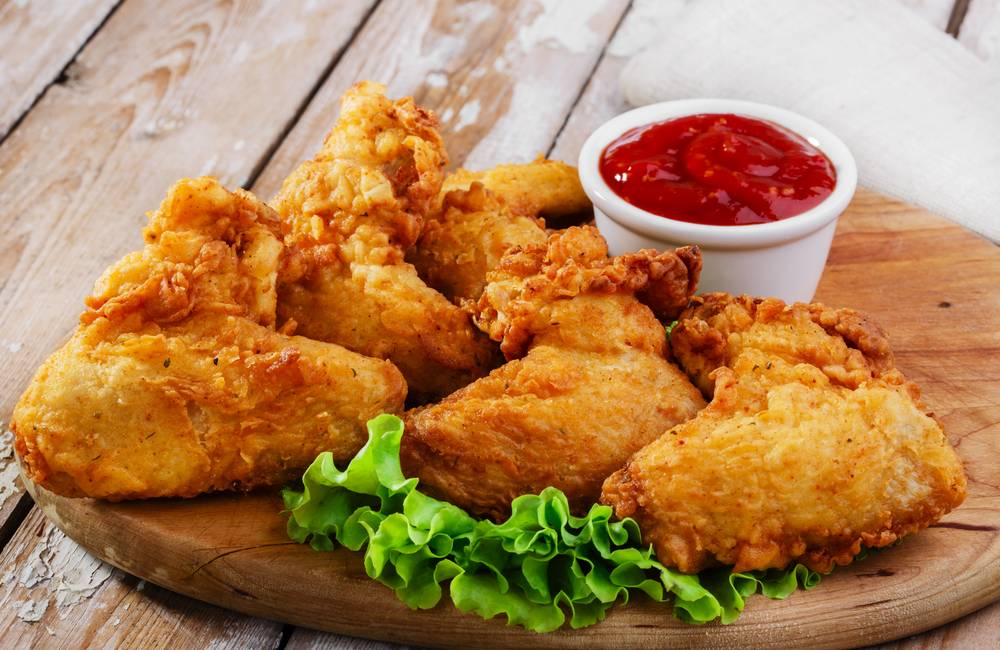 Fried Chicken ©koss13/Shutterstock.com
Fried Chicken ©koss13/Shutterstock.comThese foods are not only bad for your cholesterol, blood pressure, and heart health, but they also often lead to bloating because of how slowly they move through your G.I. tract. Even just one serving a week of fried chicken can increase your risk of premature death by 13%, according to a study done on older women (USA Today).
20. Lemon
Company: Various
Market Share: $3.7 billion by 2026*
Ingredient: Feces
There’s something about restaurant lemons that you should know, that almost everyone that works in kitchens already knows. Lemons have a very high content of feces, supposedly the highest content out of all the food in restaurant kitchens.
 Lemon ©Larisa Blinova / Shutterstock.com
Lemon ©Larisa Blinova / Shutterstock.comWe can’t attest to why, but we do know that we’ll be taking our coke without ice and a slice moving forward. Once you learn that information, you just can’t unlearn it, no matter how hard you try. Don’t be fooled by their shiny exterior, evidently there’s something sinister lurking within!
21. Frozen Broccoli
Company: Various
Market Share: $38.85 billion by 2027* (Total Frozen Vegetables Market)
Ingredient: Aphids, thrips, mites
How can frozen broccoli have something gross inside it? After all, isn’t it just an innocent vegetable that’s been frozen to hold in the freshness? Isn’t it nutritious and delicious? Well, the answer is yes, but with a slight twist.
 Frozen Broccoli ©AB-7272 / Shutterstock.com
Frozen Broccoli ©AB-7272 / Shutterstock.comLike other frozen veg, broccoli is allowed to have 60 aphids, thrips, or mites per 100 grams. There’s probably no way to stop them from getting into the crops fully, so the FDA has just given in and admitted that it’s okay to eat a tiny bug or 60 every now and then. Just don’t tell your kids.
22. Chocolate Bars
Company: Mars and others
Market Share: $114 billion total chocolate market*
Ingredient: Insect legs
We have to apologize in advance, but nothing is sacred these days. Chocolate is something most of us enjoy in hearty amounts, which is why it’s such a beloved snack food. Even chocolate isn’t safe from contamination though apparently.
 Chocolate Bars ©ivan_kislitsin / Shutterstock.com
Chocolate Bars ©ivan_kislitsin / Shutterstock.comGuidelines state that chocolate bars usually have around eight insect legs inside on average, while still passing inspection. Next time you get a crunchy bar, take a minute and think about what’s giving it that texture. Is it nuts, is it caramel, or is it a beetle that came along for the ride and died from misadventure?
23. Jelly Beans
Company: Jelly Belly and others
Market Share: $2.47 billion*
Ingredient: Shellac
A large portion of the world’s population will be familiar with shellac for a variety of reasons. Shellac is available as hard-wearing nail polish or to varnish furniture with…it’s also used on jelly beans to give them that shiny, appealing finish. As if connecting the two wasn’t bad enough, it gets worse.
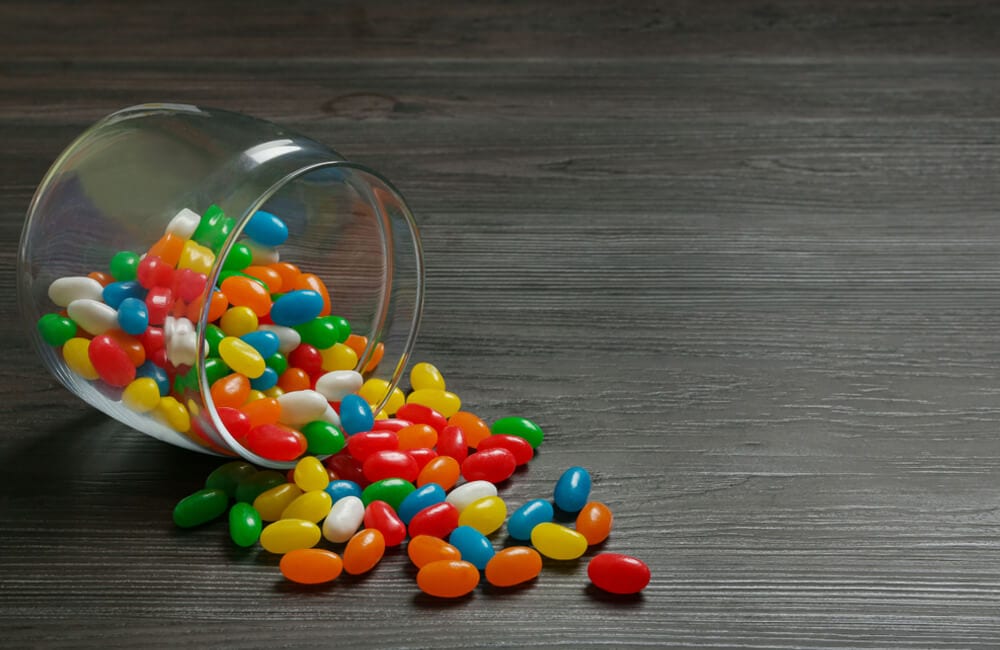 Jelly Beans ©New Africa / Shutterstock.com
Jelly Beans ©New Africa / Shutterstock.comShellac is actually made from a female lac bug that lives on a diet of tree sap. The little bugs are harvested, processed, and eventually find their way onto a ton of different confectionary products, including brands like Jelly Belly and many others you can pick up at different stores like Costco.
24. Packaged Bread
Company: Grupo Bimbo and others
Market Share: $42.4 billion*
Ingredient: L-cysteine
There was a time (albeit many moons ago) when sliced bread was just a dream. People had to bake their own or buy straight from the baker, but these days it’s a common household item. However, there’s a reason why freshly-baked bread only lasts a couple of days when packaged bread can last weeks.
 Packaged Bread ©CGN089 / Shutterstock.com
Packaged Bread ©CGN089 / Shutterstock.comIt’s all down to L-cysteine, which isn’t just any old regular preservative. The compound is natural, but that doesn’t make it any better. It’s actually derived from human hair. According to Disney’s Vice, the most popular source for this is hair salons in China. Hair is swept up, dissolved in acid, the L-cysteine is removed, and away it goes to bakeries to go into bread.
25. Cheese
Company: Schuman’s Fairfield and others
Market Share: $123.87 billion*
Ingredient: Goat stomach lining (aka rennet)
Cheese is a wonderful thing that makes a ton of companies a very healthy amount of money on a yearly basis. It’s one of the most popular and most commonly bought foods around the world, but have you ever stopped to think what might be in it?
 Cheese ©MaraZe / Shutterstock.com
Cheese ©MaraZe / Shutterstock.comA block of dairy goodness might be the first thing on our Kroger shopping lists, but what if we told you that cheese is actually made with the stomach lining of a goat, calf, or lamb? What’s even more disturbing is that the animal in question has to be a baby and still be nursing from its mother in order for the right enzyme to be present.
26. Rice
Company: Various
Market Share: $287.45 billion*
Ingredient: Arsenic
Tons and tons of rice are consumed across the world, so it can’t possibly be bad for you…can it? We would like to think that it wouldn’t, but rice actually has something lurking in it that could cause you serious problems. Rice has a habit of absorbing arsenic from its environment which means you could potentially be eating it.
 Rice ©gotphotos / Shutterstock.com
Rice ©gotphotos / Shutterstock.comIt’s no one’s fault and it likely wouldn’t be enough to harm you, but it’s not exactly going to make sushi a welcome dinner choice after hearing this. Brown rice usually has more of the toxin than other variations do, though it also has more nutrients and health benefits too.
27. Chewing Gum
Company: Wrigleys and others
Market Share: $32.63 billion*
Ingredient: Lanolin or sebum
Chewing gum has been around for years. Some think it’s a filthy habit, but if they knew exactly what was in it, they might think it’s even worse. In order to make the gum nice and chewy and give it that famous texture, companies often use lanolin.
 Chewing Gum ©Billion Photos / Shutterstock.com
Chewing Gum ©Billion Photos / Shutterstock.comLanolin may sound harmless, but it’s actually something that oozes from sheep wool. The human equivalent of this is sebum, which is basically a type of oil that comes out of our pores. So, next time you buy a bumper pack of gum from Amazon to tide you over, it’s worth pausing and remembering exactly what you’re putting in your mouth.
28. Marshmallows
Company: Rocky Mountain and others
Market Share: $342 million*
Ingredient: Hides and bones of pigs and cows (aka gelatin)
By this point in our lives, most of us know that gelatin is a common ingredient in many different foods, such as different types of candy. However, did you know that mushed-up cow and pig bones are actually used to make marshmallows, too?
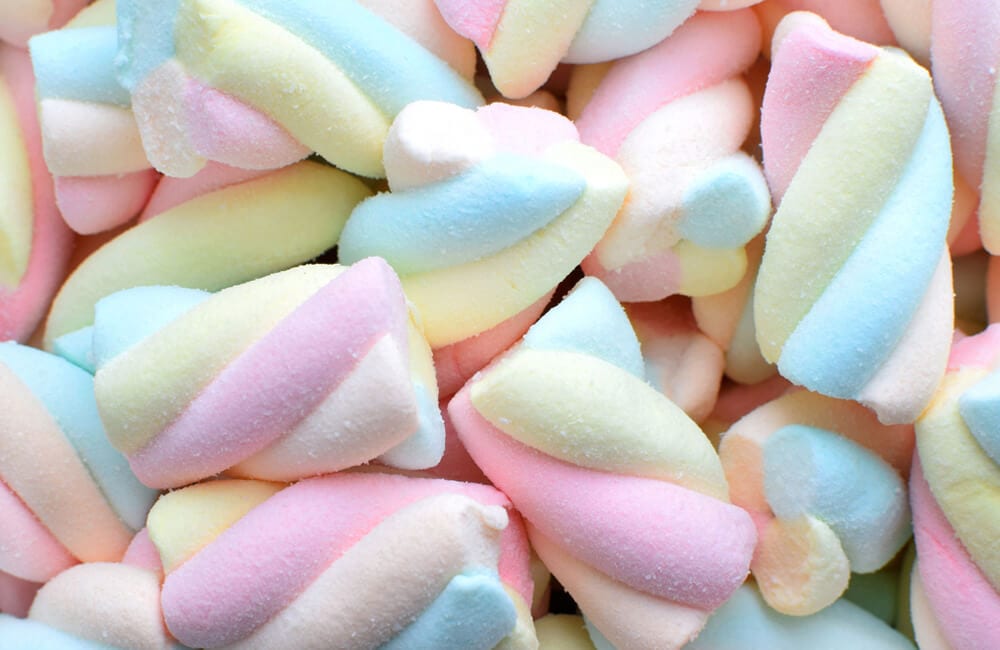 Marshmellows ©Oksana Lyskova / Shutterstock.com
Marshmellows ©Oksana Lyskova / Shutterstock.comNext time you throw a pack of them into your cart at Walmart you might want to remember what’s actually inside these fluffy balls of deliciousness. The sugar might help conceal the fact that you’re actually devouring boiled animal carcass, but make no mistake – it’s still there, even if you can’t taste it.
29. Worcestershire Sauce
Company: Lea & Perrins
Market Share: $1.102 billion*
Ingredient: Anchovies fermented in vinegar
The world is divided into two types of people: those who love anchovies and those who hate them with a passion. The salty fish are quite polarizing when it comes to taste, but their rich flavor makes them a staple ingredient in some foods, even if you don’t realize it.
 Worcestershire Sauce ©Ralf Liebhold / Shutterstock.com
Worcestershire Sauce ©Ralf Liebhold / Shutterstock.comWorcestershire sauce is predominantly popular in Britain, but it’s still available in the US. Brands like Lea & Perrins actually use anchovies that have been fermented in vinegar for over a year and a half. That’s probably why it’s got such a salty kick and a very pronounced flavor.
30. Canned Mushrooms
Company: Various
Market Share: $8 billion*
Ingredient: Maggots and mites
Let’s face it, mushrooms grow from the ground. They’re literally fungi that happen to taste delicious, but all isn’t exactly as it seems when it comes to canned mushrooms. It’s not so much about the mushrooms themselves, but what else is allowed in the can with them.
 Canned Mushrooms ©HandmadePictures/Adobe
Canned Mushrooms ©HandmadePictures/AdobeFDA guidelines actually allow a certain number of maggots into the cans. Around 30 maggots per can are actually deemed safe by the organization, as are 75 mites. That’s not to say that the ones you picked up at Target actually have any in, but it’s a bit worrying to think it’s legally allowed.
31. Coffee Creamer
Company: Coffee-Mate
Market Share: $2.884 billion*
Ingredient: Oil
There’s a lot to be said for black coffee and a no-nonsense cup of java. If you take your coffee white and typically use creamer, then that’s okay too – depending on what type of creamer you use. Some non-dairy creamers are actually a little bit…interesting.
 Coffee Creamer ©ThamKC / Shutterstock.com
Coffee Creamer ©ThamKC / Shutterstock.comLiquid Coffee-Mate uses water, syrup solids, and soybean oil to achieve the same consistency as milk. So, in short, it’s not really creaming your coffee at all, it’s just giving it a hearty dose of oil which is what makes it taste so smooth. You wouldn’t find that on the menu at Starbucks.
32. Jell-O
Company: Jell-O
Market Share: $688 million annual sales in 2021*
Ingredient: Cow and pig hides (aka gelatin)
Wibbly wobbly Jell-O can be used for a ton of things, from dessert to an after-school snack. It’s so popular it’s basically part of pop culture history, but when you take a step back and think about what it’s made of, it can taint fond childhood memories.
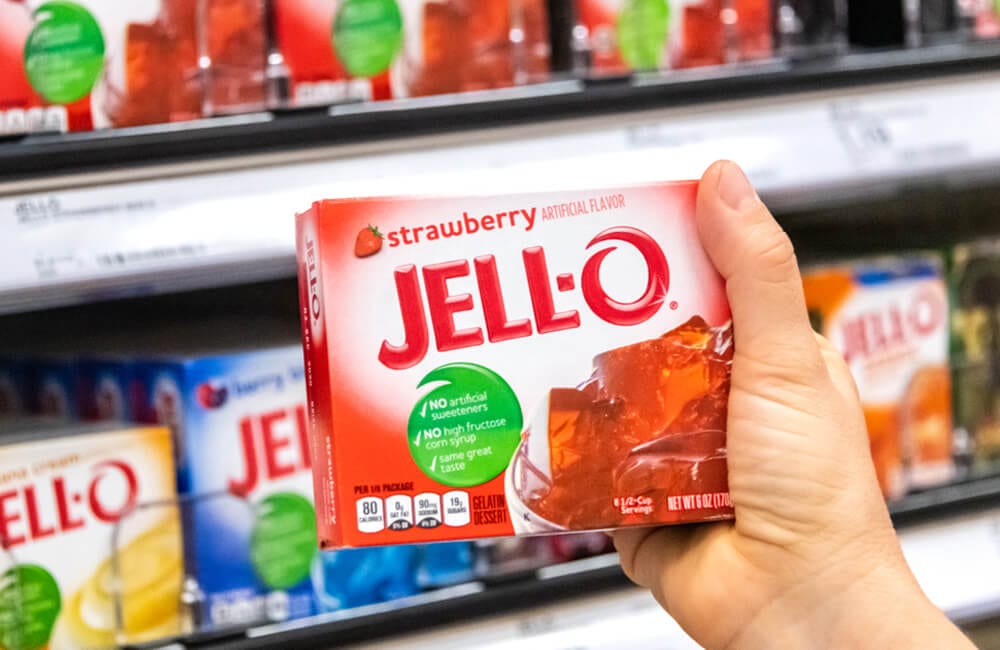 Jell-O ©calimedia / Shutterstock.com
Jell-O ©calimedia / Shutterstock.comGelatin is the main ingredient in Jell-O, alongside sugar and flavoring. Essentially, it’s boiled animal carcasses.
33. Caesar Salad
Company: Various
Market Share: 23.15% market adoption in restaurants*
Ingredient: Anchovies
If you’re a vegetarian, ordering a salad while eating out might seem like a really safe bet. After all, there’s no meat in a Caesar salad if you ask for it without chicken, right? It’s true to some extent. After all, lettuce is a vegetable, but there’s a catch.
 Caesar Salad ©nadianb / Shutterstock.com
Caesar Salad ©nadianb / Shutterstock.comOne of the most well-liked things about this type of salad is the dressing, but it’s not vegetarian. In fact, a lot of pre-made Caesar salads actually have dressings made from anchovies. Yep, those pesky little fish are at it again, with companies like Kraft owning up to the fact there are fish allergens contained in their dressings…
34. Parmesan
Company: Kraft and others
Market Share: $160 billion*
Ingredient: Cellulose/wood pulp
It’s difficult to imagine that the tasty cheese you sprinkle on your pasta has anything in it other than dairy, but the reality is quite different. In fact, the lion’s share of parmesan brands out there actually incorporates wood pulp into the mix.
 Grated Parmesan ©Nitr / Shutterstock.com
Grated Parmesan ©Nitr / Shutterstock.comIt’s not some shady trick, but an open FDA-approved secret. The wood pulp, otherwise known as cellulose, is a natural ingredient that is a proven and well-used anti-clumping ingredient. It’s not just parmesan that has this, but tons of different grated cheeses as it stops lumps forming.
35. Orange Juice
Company: Del Monte and others
Market Share: $143.08 billion total fruit juice market*
Ingredient: Ethyl butyrate
If you’re partial to a glass of orange juice in the morning and don’t want to give it up, then you might want to look away now. No matter how “freshly squeezed” orange juice from a carton may seem, a lot of different brands rely heavily on chemicals for flavor.
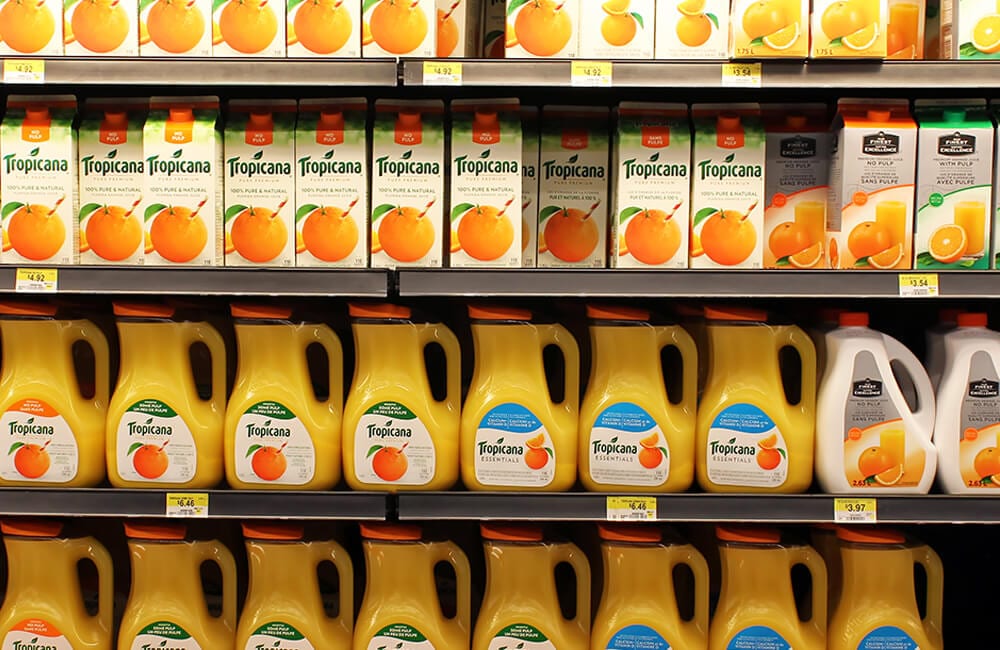 Orange Juice ©Niloo / Shutterstock.com
Orange Juice ©Niloo / Shutterstock.comFor example, ethyl butyrate is commonly used to insert a hefty amount of artificial flavoring into orange juice. Of course, fresh juice needs to be preserved somehow and this process often means the flavor takes a hit. By hitting the mix with an artificial compound like this, companies are able to finely tune the taste.
36. Enhanced Chicken
Company: Various
Market Share: $196 billion total chicken market*
Ingredient: Sodium
There are tons of different types of food on the market that have a high amount of sodium in it, but sometimes this is just because of the mix of ingredients. In other cases, it’s been intentionally done for cosmetic reasons.
 Enhanced Chicken ©Goncharov_Artem / Shutterstock.com
Enhanced Chicken ©Goncharov_Artem / Shutterstock.comCompanies have been pumping saltwater into the chicken for eons for a number of reasons. Not only does it make the meat look juicier and more appetizing, but it also bumps the weight up so farmers can get more for their money. Unfortunately for the consumer, it means the sodium levels in meat are often sky-high.
37. Enhanced Beef
Company: Various
Market Share: $468 billion total beef market*
Ingredient: Sodium
The heavier the meat, the more money farmers get. The juicier it looks, the better it sells in stores. With that being said, pumping cuts of beef full of saltwater isn’t a new practice by any means. You may have noticed that beef often shrinks when it’s being cooked.
 Enhanced Beef ©Andrei Iakhniuk / Shutterstock.com
Enhanced Beef ©Andrei Iakhniuk / Shutterstock.comThat’s thanks in part to the water seeping out. Water is one thing, but saltwater actually ends up giving the beef a much higher sodium content that isn’t healthy. Too much salt in the diet can cause all sorts of problems for humans, so be extra picky when shopping for dinner in the future!
38. Honey
Company: Clover and other brands
Market Share: $8.58 billion*
Ingredient: Bee vomit
We all love a little bit of honey, whether it’s spread on toast, spooned into tea, or drizzled over granola. But, have you ever stopped to think about just how honey is really made? We all know it comes from bees, but how do bees make it?
 Honey ©id-art / Shutterstock.com
Honey ©id-art / Shutterstock.comBees actually have a whole separate stomach that produces honey where they hoard nectar. When the time comes, the bees essentially vomit it back up, and eventually, it becomes honey. This one is gross in terms of biology, but in reality, honey is still an amazing product that we should all eat more of.
39. Whey
Company: Variou
Market Share: $10.3 billion*
Ingredient: Curdled milk
Whey protein has been on the up and up in terms of popularity for years. Bodybuilders use it to bulk up and it’s largely considered one of the best-selling fitness supplements on the market. Many different companies sell it, but what is it?
 Whey ©Enfoca y dispara / Shutterstock.com
Whey ©Enfoca y dispara / Shutterstock.comBrace yourself, because whey powder is nothing but curdled milk in a fancy tin. Whey is the part of the milk that’s leftover when the water runs off, which is then dried and marketed to the masses. It does mean that you can’t consume it if you’re dairy-free, but is it gross enough to be taken off the market? Apparently not.
40. Diet Soda
Company: Coca-Cola and others
Market Share: $5 billion*
Ingredient: Aspartame
Whoever invented soda deserves a pat on the back because they spawned one of the biggest industries of all time, paving the way for titans of industry like Coca-Cola. However, soda companies soon realized that there was a market for diet drinks that were low-calorie and didn’t contain sugar.
 Diet Soda ©BrandonKleinPhoto / Shutterstock.com
Diet Soda ©BrandonKleinPhoto / Shutterstock.comThe only downside is that these products didn’t taste as good, which is where artificial sweeteners come in. Aspartame is one of the most commonly used sweeteners, but it has a bad rep as links were once drawn between the consumption of it and cancer. It’s also thought to block a major protein that helps you lose weight – which ultimately defies the point.
41. Strawberry Ice Cream
Company: Various
Market Share: $79 billion global ice cream market*
Ingredient: Beaver butt (aka castoreum)
The wonderful world of food innovation often requires chefs to come up with new things, but did you know that there’s a good chance you’ve consumed beaver butt in your life? Also known as castoreum, the substance is actually secreted from a beaver’s behind and supposedly adds flavor to things like ice cream.
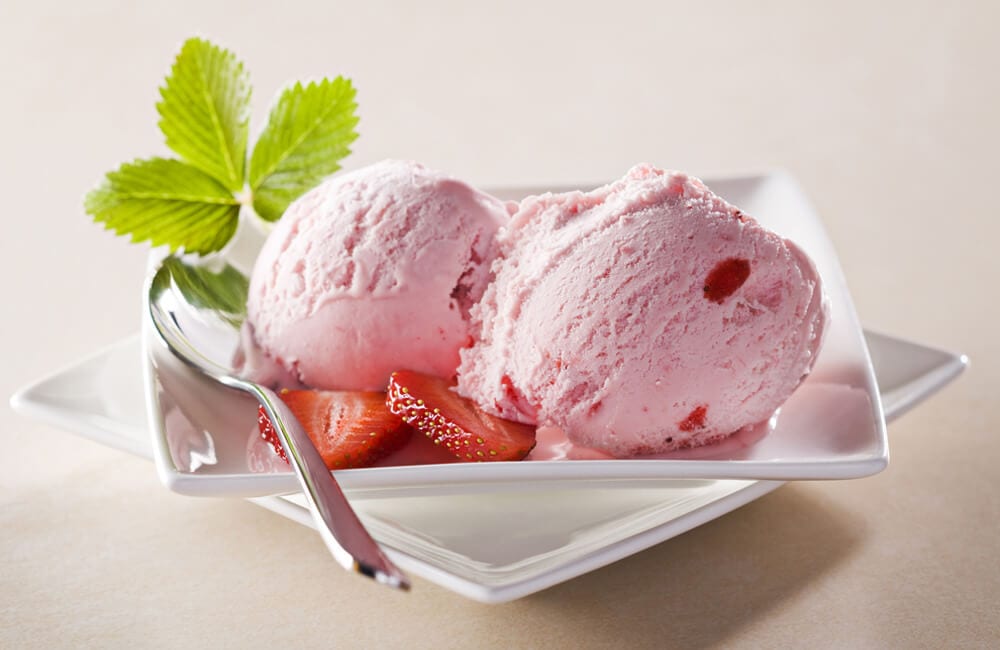 Strawberry Ice Cream ©USAN ZIDAR / Shutterstock.com
Strawberry Ice Cream ©USAN ZIDAR / Shutterstock.comMost of the time, manufacturers simply dub it “natural ingredients” on the packaging, as they’re not legally required to reveal the fact it’s essentially butt juice. Let’s face it, if we knew what was in it, we wouldn’t buy it.
42. Raspberry Flavored Lollipop
Company: Various
Market Share: $240 billion total candy market*
Ingredient: Beaver butt (aka castoreum)
Lollipops come in many different flavors, but raspberry ones might have an extra added ingredient that could have you retching in no time. You wouldn’t think it from the taste, but raspberry lollipops could actually have a very natural, very odd ingredient in them.
 Raspberry Flavored Lollipop ©virtualpictures.com/Adobe
Raspberry Flavored Lollipop ©virtualpictures.com/AdobeYep, we’re talking about beaver butt juice, aka castoreum. This “natural ingredient” is in far more things than you realize. Seeing as it’s totally natural and not harmful, manufacturers don’t have to put exactly what it is on the box. Let this be a lesson to you – you never really know what you’re consuming.
43. Pringles
Company: Pringles
Market Share: $2.35 billion company valuation in 2012*
Ingredient: Sodium Bisulfate
Most of us wouldn’t make a link between Pringles and toilet cleaner, would we? The two products are so vastly different that it seems impossible to draw any comparisons between them. In actuality, there’s a big link between them that most people just don’t recognize.
 Pringles ©Mehaniq / Shutterstock.com
Pringles ©Mehaniq / Shutterstock.comSodium bisulfate is an ingredient used in Pringles, but it’s also used in household cleaners like toilet cleaner, dishwasher tablets, and more. While these products have a lot more in them than Pringles do, it’s interesting to think you’re ingesting something used to scrub limescale.
44. White Flour
Company: Various
Market Share: $161 billion*
Ingredient: Chlorine Dioxide
White flour that we use to bake cakes looks fairly innocent on the outside, doesn’t it? The fluffy, soft white substance seems natural enough, but it’s not exactly what it says on the tin. Some brands actually use chlorine dioxide gas to make the flour whiter.
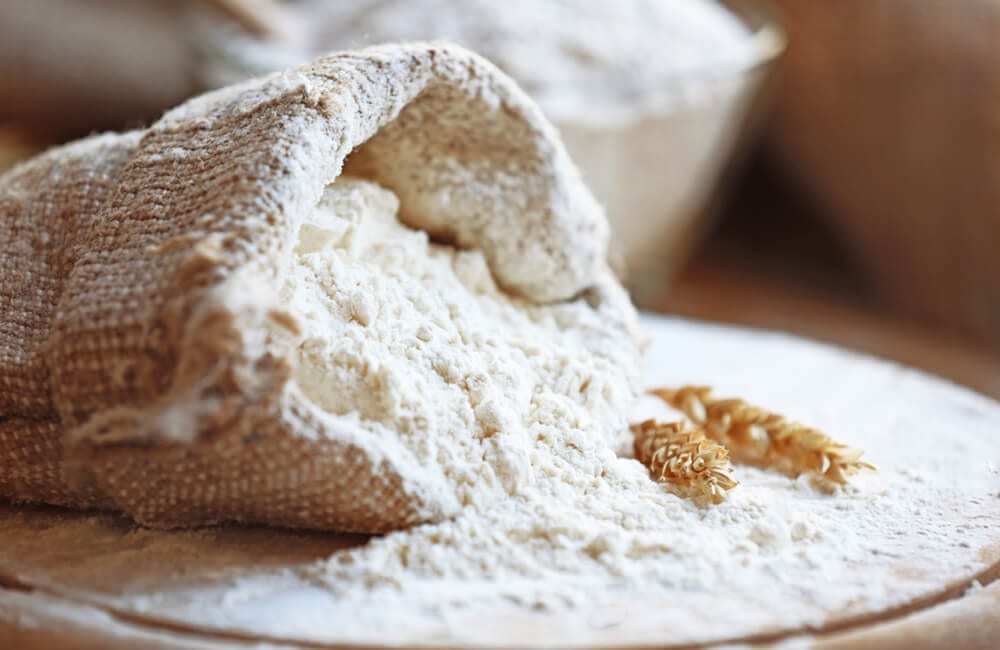 White Flour ©Africa Studio / Shutterstock.com
White Flour ©Africa Studio / Shutterstock.comBreathing in this substance has actually been known to cause health problems such as lung issues and even pulmonary edema. The more you breathe in, the worse it gets. So, next time you pick some up, make sure to double-check the ingredients list twice. Chlorine dioxide gas is also used in labs to sterilize equipment.
45. Vanilla Ice Cream
Company: Various
Market Share: $79 billion global ice cream market*
Ingredient: Castoreum
Beavers have lovely butts, apparently. We’re not sure who discovered that a beaver’s butt actually tastes like vanilla, but it’s probably a good thing that the person in question remains anonymous. No one wants to be known as that guy, even if it is somewhat of a food miracle.
 Vanilla Ice Cream ©5PH / Shutterstock.com
Vanilla Ice Cream ©5PH / Shutterstock.comVanilla ice cream is one of the numerous food products that could have beaver butt juice in it. It’s not known exactly which companies utilize this gift from God as anonymity seems to be a key issue when it comes to the secretions of this little mammal.
46. Red Colored Candy
Company: Various
Market Share: $240 billion total candy market*
Ingredient: Carmine
Red is a beautiful color for candy. It’s vibrant, inviting, and it looks juicy. That’s why it’s such a popular choice for many companies, from Twizzlers to Skittles. It’s no secret that coloring is used to achieve this, but did you know that one particular source of red is carmine?
 Red Colored Candy ©Africa Studio / Shutterstock.com
Red Colored Candy ©Africa Studio / Shutterstock.comCarmine comes from the bellies of female African beetles. They’re essentially squished and milked for their color which is sometimes noted as Natural Red #4. Some might say it’s better than using an artificial source, but still – beetle bellies. Gross.
47. Shredded Cheese
Company: Various
Market Share: $40 billion*
Ingredient: Cellulose
We all love our cheese, but if we knew what was really in it, would we eat it so much? Shredded cheese is the worst of all thanks to an added ingredient. Have you ever wondered why cheese you grate yourself ends up clumping, while store-bought stuff doesn’t?
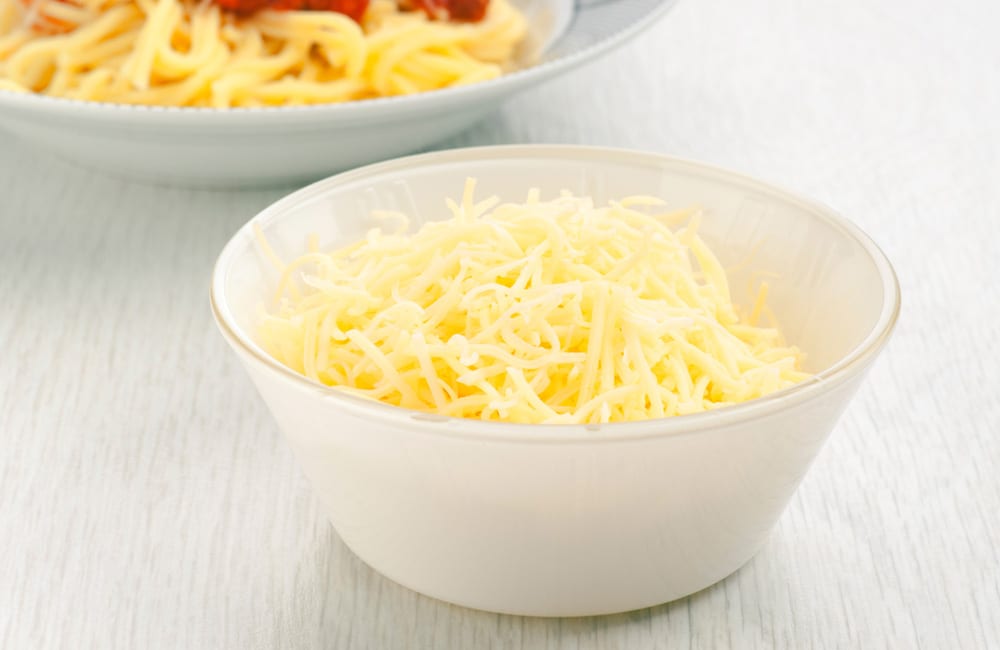 Shredded Cheese ©jultud / Shutterstock.com
Shredded Cheese ©jultud / Shutterstock.comThe answer is simple: cellulose! Cellulose is essentially wood pulp, aka sawdust. It’s added to the cheese to stop it from sticking together and becoming hard. It’s safe to consume, but it’s still a little weird to know we’re downing wood chippings, isn’t it?
48. Wine
Company: Various
Market Share: $435 billion*
Ingredient: Egg whites
What could possibly be lurking in our lovely glass of white wine that isn’t grapes and booze? Well, as it turns out, quite a lot. Wine can harbor some very interesting ingredients that you just wouldn’t expect, including (but definitely not limited to) egg whites.
 Wine ©Africa Studio / Shutterstock.com
Wine ©Africa Studio / Shutterstock.comApparently, egg whites can clarify the wine, giving it a nice crystal-clear appearance. So, next time you order that glass while out at dinner, be sure to toast to the chickens too for giving you such an aesthetically pleasing glass of wine. There’s more stuff in there other than egg whites, too, but we’ll let you figure that out!
49. Fat Free Milk
Company: Various
Market Share: $5.5 billion by 2029*
Ingredient: Powdered milk
We all like to think that when we get milk from the store, we’re getting a really decent product. While that’s undoubtedly the case with a lot of companies, others may be hesitant to tell you what’s in their mix, especially if it’s fat-free.
 Fat Free Milk ©Photoongraphy / Shutterstock.com
Fat Free Milk ©Photoongraphy / Shutterstock.comA lot of businesses actually use powdered milk in their fat-free milk to help bulk it out and seem less watery. You know what’s even worse? No one is actually legally required to tell you that this is in the milk because it’s technically still the same main ingredient. It’s not quite so fresh-looking now, is it?
50. Tomatoes In A Can
Company: Hunt’s and others
Market Share: $19.5 billion by 2030*
Ingredient: BPA
For those who don’t know, Bisphenol A is an industrial chemical used to produce epoxy and polycarbonate plastics. Sounds appetizing, right? This might surprise you, but BPA is lurking in a lot of our canned foods, including canned tomatoes. In fact, according to Cook’s Illustrated, canned tomatoes are “of particular concern.”
 Tomatoes In A Can ©BrunoRosa / Shutterstock.com
Tomatoes In A Can ©BrunoRosa / Shutterstock.comCanned tomatoes have a lot of acidity, which can cause the BPA in the cans to leach out over time, particularly if the cans become scratched, dented, or damaged somehow. Studies on canned tomato cans revealed the BPA levels ranging from 0.33 to 17.4 micrograms per can. Yikes!
51. Artificial Sweetener
Company: Splenda, Sweet ‘n Low
Market Share: $12 billion by 2032*
Ingredient: Aspartame
Aspartame has long been revealed to not be the calorie-free sweetener we all thought it was. As it turns out, artificial sweeteners can cause a lot of problems. According to the U.S. Right to Know, there are dozens of possible health ramifications tied to the same sweetener found in “diet” soda.
 Artificial Sweetener ©Andrey_Popov / Shutterstock.com
Artificial Sweetener ©Andrey_Popov / Shutterstock.comAccording to the USRTK, health risks include cancer, Alzheimer’s disease, dementia, stroke, cardiovascular disease, mood disorders, headaches, migraines, and more. Though some people might order a diet drink to try to lose weight, evidence suggests that it could have the opposite effect. We think we’ll just stick to water, next time.
52. French Fries
Company: McDonald’s
Market Share: $15.87 billion*
Ingredient: Additives, preservatives
When McDonald’s released a list of the ingredients in its French fries a few years ago, people were surprised. French fries should technically just have three ingredients: potatoes, oil, and salt. However, the list the fast food chain released had a diorama of twenty-plus ingredients, including a ton of preservatives.
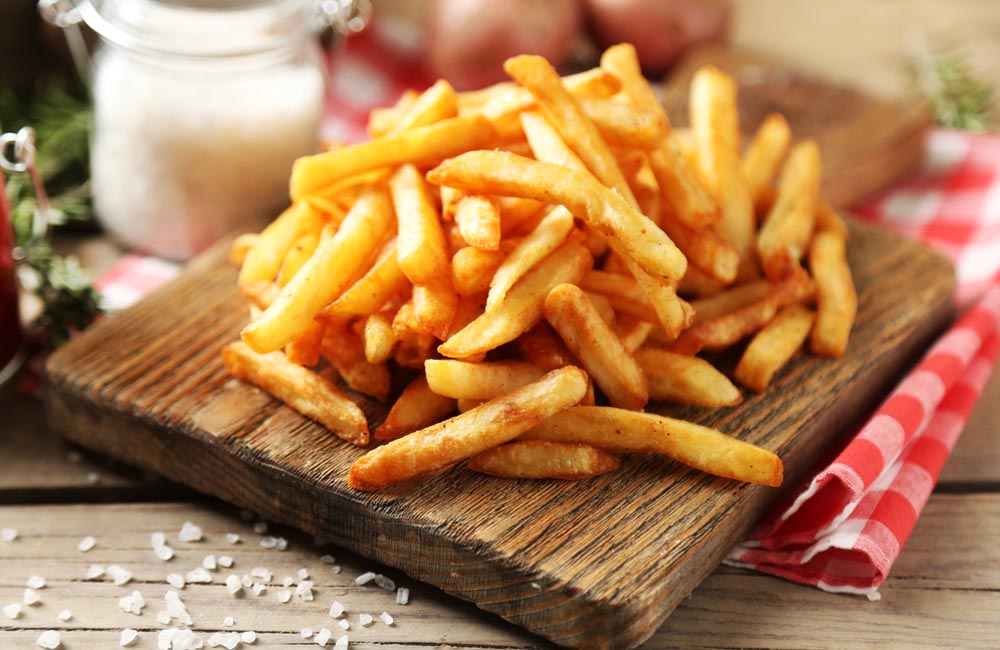 French Fries ©Africa Studio / Shutterstock.com
French Fries ©Africa Studio / Shutterstock.comThe fries are fried in a bunch of different oils, and they’re chock-full of preservatives like tertiary butylhydroquinone (always a bad sign if you can’t pronounce an ingredient) and citric acid, as well as dimethylpolysiloxane, which is an anti-foaming agent that keeps the oil from splattering. Looks like a crispy, crunchy fry isn’t quite as simple as we thought it was.
53. Yoghurt
Company: Dannon, Yoplait, and others
Market Share: $171.83 billion by 2031*
Ingredient: Aspartame
It’s a lose-lose situation when it comes to yogurt. On the one hand, yogurt with no artificial sweeteners is often high in sugar and carbs, which can wreak havoc on the body, particularly if you’re prediabetic or diabetic. On the other hand, when yogurt is sugar free, it has artificial sweeteners like aspartame.
 Yoghurt ©Madele / Shutterstock.com
Yoghurt ©Madele / Shutterstock.comAs discussed above, aspartame is gross and can cause a myriad of health problems. So, what’s a yogurt-lover to do? One suggestion for those looking for something sweet is to buy unsweetened Greek yogurt and add a bit of honey to it. It’ll be healthy yet tasty.
54. Toaster Pastries
Company: Pop Tarts
Market Share: $1 billion in Pop Tart sales per year*
Ingredient: Trans fats, sugar
Healthline took a shot at Pop Tarts in 2017, calling them one of the fifteen “unhealthiest junk foods in America.” Pop Tarts are convenient and delicious. You pop them in the toaster, wait a couple of minutes, and then voila! You have a warm, gooey pastry that is a sweet start to your day.
 Toaster Pastries ©Brent Hofacker / Shutterstock.com
Toaster Pastries ©Brent Hofacker / Shutterstock.comThough that sounds nice, the reality behind toaster pastries like Pop Tarts is that they’re full of sugar and carbs. A couple of Frosted Strawberry Pop Tarts contain seventy-six carbs, the majority of which comes from sugar. When you’re thinking of a healthy start to the day, sadly, toaster pastries shouldn’t make your list.
55. Pork Rinds
Company: Rudolph Foods and others
Market Share: $630 million*
Ingredient: Sodium nitrates, preservatives
To be fair, this one can’t have come as a shock. Pork rinds are pig skin that has been rendered, roasted, or fried in fat. Already, that doesn’t exactly sound as healthy as a green salad. However, just how bad pork rinds are is not commonly known.
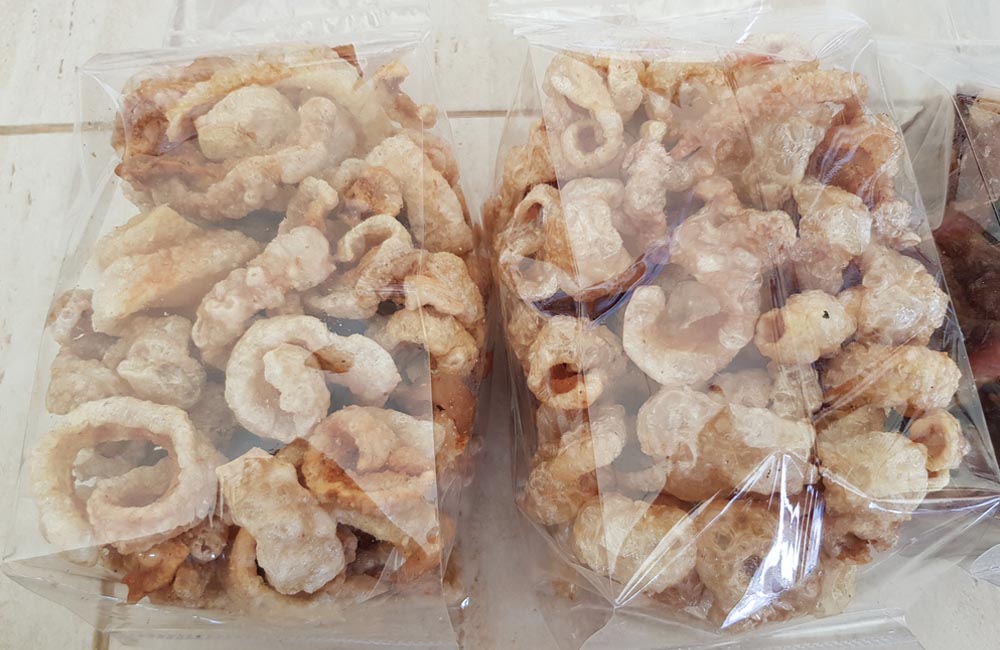 Pork Rinds ©thanapornnutt / Shutterstock.com
Pork Rinds ©thanapornnutt / Shutterstock.comYou might have guessed that this admittedly-delicious snack is high in cholesterol, sodium, and saturated fat, a deadly combo that can raise your LDL (“bad”) cholesterol. But, pork rinds are also high in preservatives and flavor-enhancers like MSG. Though people might want them because they’re high-protein and low-carb, these rinds shouldn’t be a go-to snack every day.
56. Sugary Coffee Drinks
Company: Starbucks, Dunkin’ Donuts, etc.
Market Share: $26.58 billion annual revenue for Starbucks*
Ingredient: Sugar, dairy fat, artificial flavoring
Take a step back before you order that white chocolate mocha with whole milk and whipped cream from Starbucks. Eat This Not That described that exact drink as one of the eight “worst coffee drinks in America.” Though we all like a sweet pick-me-up every now and again, sugary coffee drinks are filled with, well, sugar.
 Sugary Coffee Drinks ©vovidzha / Shutterstock.com
Sugary Coffee Drinks ©vovidzha / Shutterstock.comThe Au Bon Pain Mocha Latte, Tim Hortons Mocha Iced Capp, Dunkin’ Butter Caramel Swirl Frozen Coffee with Whole Milk (come on, that last one just sounds unhealthy), and more can throw your blood sugar way out of whack. According to Business Insider, a scientific study of over 118,000 people showed that the more sugar they drink, the more likely they are to die from illnesses like heart disease.
57. White Rice
Company: Nikishi and others
Market Share: $287.45 billion*
Ingredient: Sugar
Harvard Medical School shot us in the heart when they revealed that white rice was bad. Technically, considering the bad rap that white bread has gotten, this shouldn’t have come as a shock, but it was still a huge bummer.
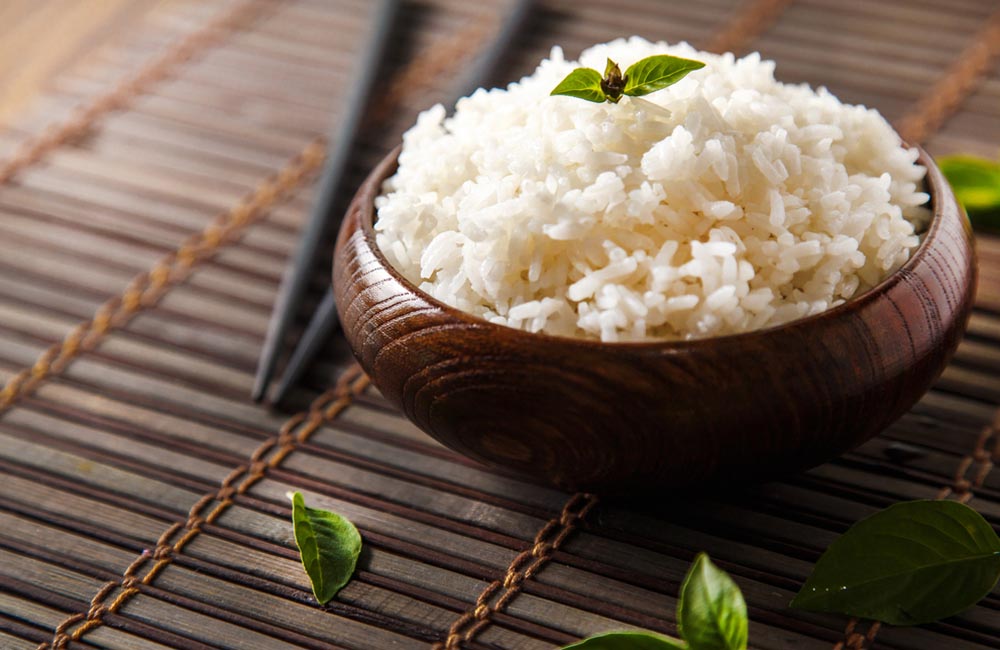 White Rice ©Noppadon stocker / Shutterstock.com
White Rice ©Noppadon stocker / Shutterstock.comHarvard said that white rice provides a blood sugar spike that is the equivalent of “eating pure table sugar.” White rice has a far higher glycemic index than its less-delicious sibling, brown rice. If you’re trying to eat a healthy diet, you’ll have to adjust to brown rice, as it is high in magnesium, fiber, and won’t drop-kick your blood sugar into the stratosphere.
58. Swordfish
Company: N/A (It’s the fish itself)
Market Share: $275 billion seawater fish market*
Ingredient: Mercury
This one really isn’t about the companies harvesting and producing swordfish, so much as it is about the fish itself. In 2004, the F.D.A. cautioned people against eating swordfish (along with shark, tilefish, and King Mackerel) because of its high level of mercury. Eating mercury in high quantities can be poisonous.
 Swordfish ©Brent Hofacker / Shutterstock.com
Swordfish ©Brent Hofacker / Shutterstock.comSwordfish is high in mercury because it’s a predator. These pointy-nosed fish might look absurd, but they’re smaller fishes’ worst nightmare when they’re in the water. They prey on other fish, absorbing their mercury too when they eat them. If you’re looking for a low-mercury alternative to swordfish, try light tuna, shrimp, pollock, catfish, and every health nut’s favorite, salmon.
59. Canned Soup
Company: Campbell’s and others
Market Share: $2.8 billion*
Ingredient: MSG, BPA
In addition to the ever-present danger of BPA lurking in cans, canned soup is high in some other nasty ingredients, including monosodium glutamate, better-known as a MSG. Canned soup companies use MSG to accentuate the food’s “meatiness,” which just sounds gross.
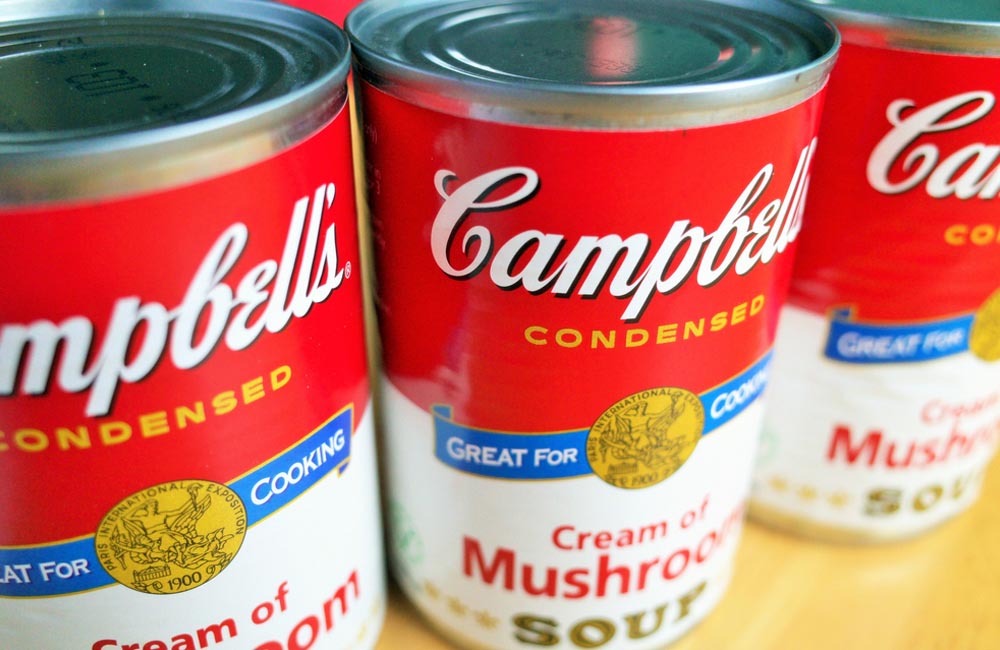 Canned Soup ©Thinglass / Shutterstock.com
Canned Soup ©Thinglass / Shutterstock.comMSG is a neurotoxin in its purest form, so having it in any diluted form is just less-than-ideal. When you put aside the preservatives and BPA, there still remains another huge problem with canned soup: the sodium. Soup manufacturers can add as much as 1,200 milligrams a can. If you eat that day after day, you’ll run the risk of weight issues and heart disease.
60. Flavored Instant Oatmeal
Company: Quaker Oats and others
Market Share: $3.53 billion by 2027*
Ingredient: Added sugar, sodium
There are some benefits to instant flavored oatmeal, including the fact that it is high in fiber and has whole grains. Though those are good things, there are some downsides to this so-called healthy breakfast, including the salt and sugar levels.
 Flavored Instant Oatmeal ©melissamn / Shutterstock.com
Flavored Instant Oatmeal ©melissamn / Shutterstock.comAccording to the American Heart Association, make sure you check the back of the box when you’re buying instant oatmeal. Try to find a packet with less than twelve grams of sugar per serving and less than 250 milligrams of sodium. If you can’t, try regular, unflavored oatmeal with a dash of honey or a small (and we do mean teeny-tiny) sprinkle of brown sugar added to it.
61. Boxed Vegetable Pasta
Company: Barilla, Good & Gather, etc.
Market Share: $78 billion by 2029* (Total Pasta Market)
Ingredient: Same bad stuff as regular pasta
If we were willing to take a guess, we’d assume that most people choosing veggie boxed pasta over regular pasta were doing so because they thought the former would be healthier than the latter. Well, hold onto your hats because, if you check the back of the box on both of these pastas, you’ll likely find that the two have the same high carb count.
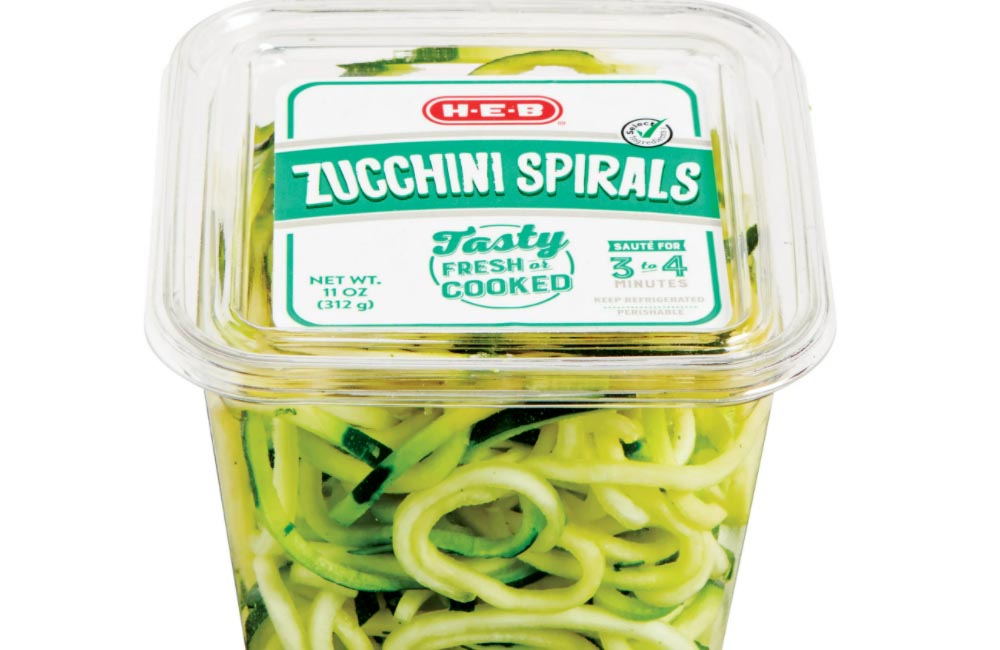 Boxed Vegetable Pasta @HEB / Pinterest.com
Boxed Vegetable Pasta @HEB / Pinterest.comShould you want a healthy vegetable pasta, consider making an investment into a spiralizer. These machines cost $30-$70 on average, and they will literally turn actual vegetables into spiral pieces of pasta. All you have to do is cook the newly-transformed vegetables (and add a healthy sauce, of course).
62. Pretzels
Company: Auntie Ann’s, Rold Gold, Utz, and more
Market Share: $7.4 billion*
Ingredient: Salt
While you probably could have guessed that the giant soft pretzels from Auntie Anne’s weren’t exactly healthy, it might surprise you to find that regular snack pretzels aren’t so great either. For a long time, pretzels have been thought of as the “safer,” healthier choices of traditional chips and candy snack items.
 Pretzel ©PosiNote / Shutterstock.com
Pretzel ©PosiNote / Shutterstock.comThough they do have fewer calories than regular fried chips, they aren’t exactly nutritious. These pretzels are high in salt, something that can cause your blood sugar to spike. Next time you’re shopping for a bag of pretzels, consider buying the unsalted kind (you’ll just have to adjust to the bland taste, sorry to say).
63. Beef Jerky
Company: Jack Links, Old Trapper, Tillamook, and more
Market Share: $1 billion*
Ingredient: Sodium
As with pretty much everything, beef jerky is bad if you consume too much of it. Though it is low in carbs, beef jerky can be high in sodium. Healthline admits that beef jerky can be considered “healthy,” but that doesn’t mean it’s free from the same risks associated with processed meats.
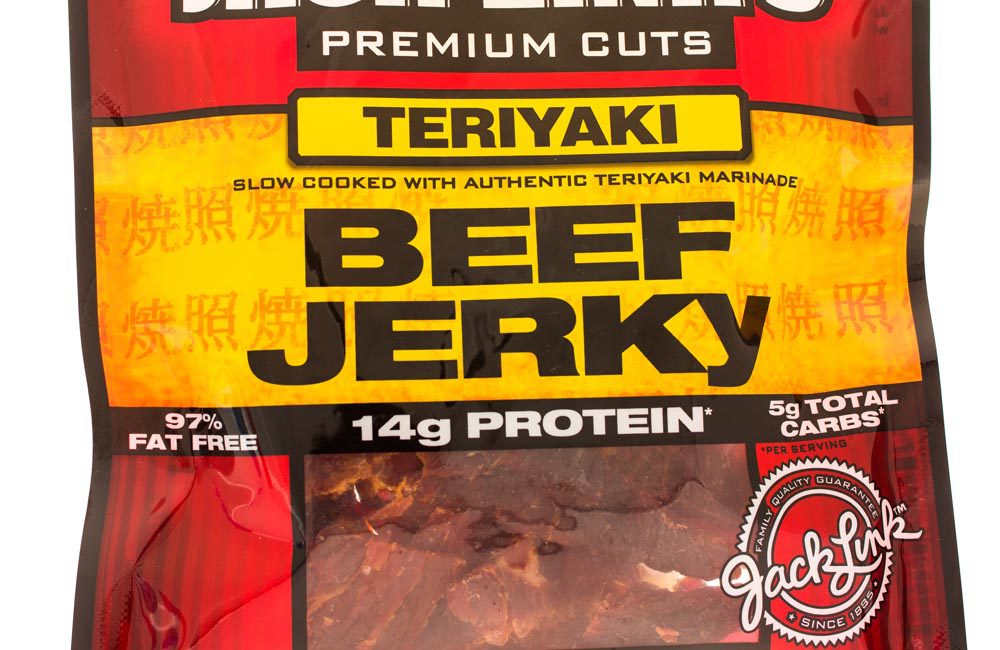 Beef Jerky ©Keith Homan / Shutterstock.com
Beef Jerky ©Keith Homan / Shutterstock.comEspecially as the keto diet has taken over, beef jerky has gotten its dried, meaty day in the sun. The jerky doesn’t produce insulin, and it digests slower than carbs. It’s also high in protein. Just be careful eating it in high quantities, as you don’t want to consume more than 2,300 milligrams of sodium per day (one piece of beef jerky has, on average, 416 milligrams).
64. Fat-Free Salad Dressing
Company: Newman’s Own and others
Market Share: $25.34 billion total salad dressing market*
Ingredient: No fat (which is the problem)
There are a lot of reasons to ditch fat-free dressing, and it’s not just because it doesn’t taste as good. When you think about it, the reason most people eat a salad is because it’s low in calories and the vegetables have a lot of nutrients in them. You feel good after eating a salad. There’s no bloating that you get after you have a Big Mac and fries.
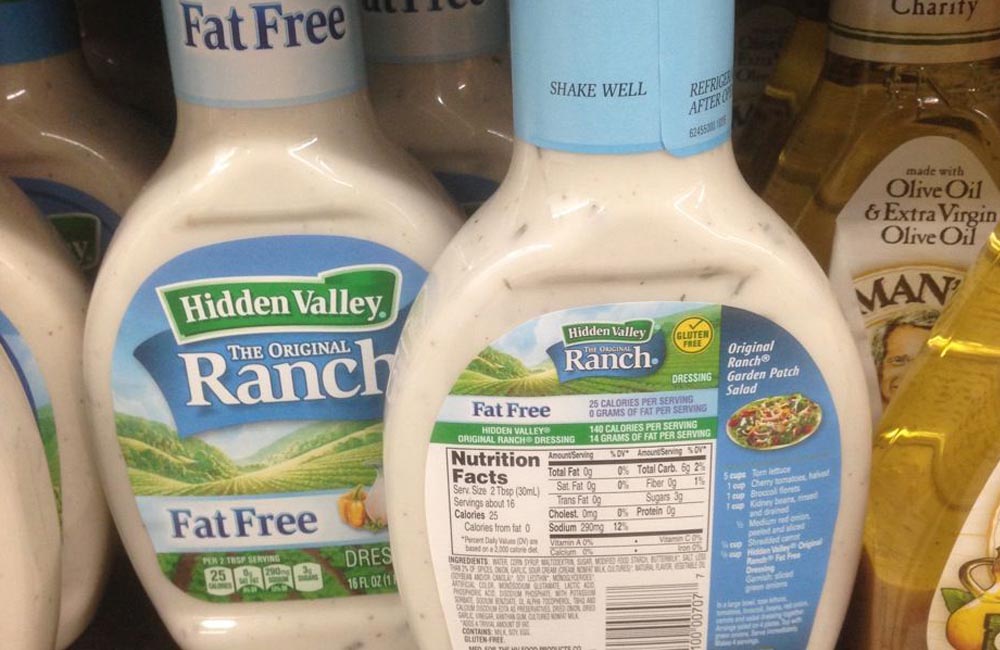 Fat-Free Salad Dressing @healthygrocery / Pinterest.com
Fat-Free Salad Dressing @healthygrocery / Pinterest.comHowever, fat-free salad dressing might undo all the progress you made eating the salad. A small, reasonable amount of fat helps your bloodstream absorb the nutrients in the salad. If you have fat-free dressing, you won’t absorb your lunch or dinner’s vitamins and minerals as well.
65. Mayonnaise
Company: Hellmans, Heinz, and more
Market Share: $8.285 billion*
Ingredient: Fat
The Times of India said that mayonnaise is one of the “unhealthiest foods you can eat.” Though mayo is a delicious condiment, assuming you’re not one of the vocal minority of people who hate it, there’s no denying that it is loaded with fat and calories. True, the fat is what makes it delicious, but a diet too high in anything can cause issues.
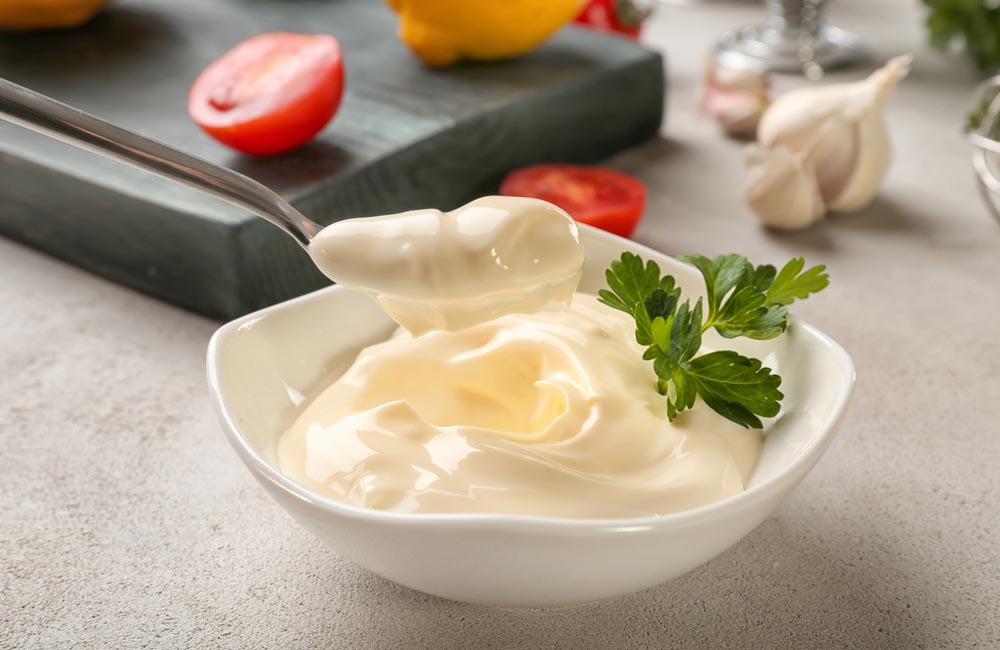 Mayonnaise ©Africa Studio / Shutterstock.com
Mayonnaise ©Africa Studio / Shutterstock.comFood Network had good news for people who love mayo. You don’t have to “ban it for life,” and it can be part of a healthy lifestyle, as long as you eat it in “very small amounts.” There are also light and reduced-fat brands available on supermarket shelves, too.
66. Whipped Cream
Company: Reddi-Whip and others
Market Share: $820 million*
Ingredient: High fructose corn syrup, hydrogenated oils
Whipped cream is a nice treat atop a hot cocoa or a latte, but you shouldn’t eat it every day. Sadly, spraying an entire bottle of Reddi-Whip into your mouth just isn’t the best option. The reason why has to do with the high fructose corn syrup, which everyone knows is food’s bad guy.
 Whipped Cream ©Roman Tiraspolsky / Shutterstock.com
Whipped Cream ©Roman Tiraspolsky / Shutterstock.comThe hydrogenated oils in whipped cream are another source of concern. According to Healthline, the trans fats in these oils have been shown to cause heart problems, as they increase LDL levels while decreasing HDL. The moral of the story? Keep the whipped cream to a minimum.
67. Kombucha
Company: KeVita, Yogi, and more
Market Share: $2.59 billion*
Ingredient: Sugar
Dentists had a lot of negative things to say about kombucha, the health craze that a lot of people swear by. Kombucha is sweet, fermented tea. It’s made of sugar, tea, and yeast. Though the ingredients list is simple, the sugar is something to watch.
 Kombucha ©TonelsonProductions / Shutterstock.com
Kombucha ©TonelsonProductions / Shutterstock.comIn addition to the negative effects of sugar on your weight and entire body (sadly, the most delicious additive is the deadliest), kombucha can be as harmful for your teeth as a sugary soda. It can cause gum disease, tooth decay, and discoloration to the surface of your teeth. The CDC recommends not consuming more than four ounces of kombucha, one to three times a day.
68. Bacon
Company: Applegate, Market Pantry, and more
Market Share: $65.27 billion*
Ingredient: Cholesterol
Bacon is amazing, we all know that, but we’re lying to ourselves if we think it’s in any way, shape, or form healthy. Bacon might be the perfect addition to a breakfast of eggs or a sandwich (or just eaten by itself), but it is high in cholesterol. According to WebMD, the bastion of all things medical-related, each ounce of bacon has 30 milligrams of cholesterol.
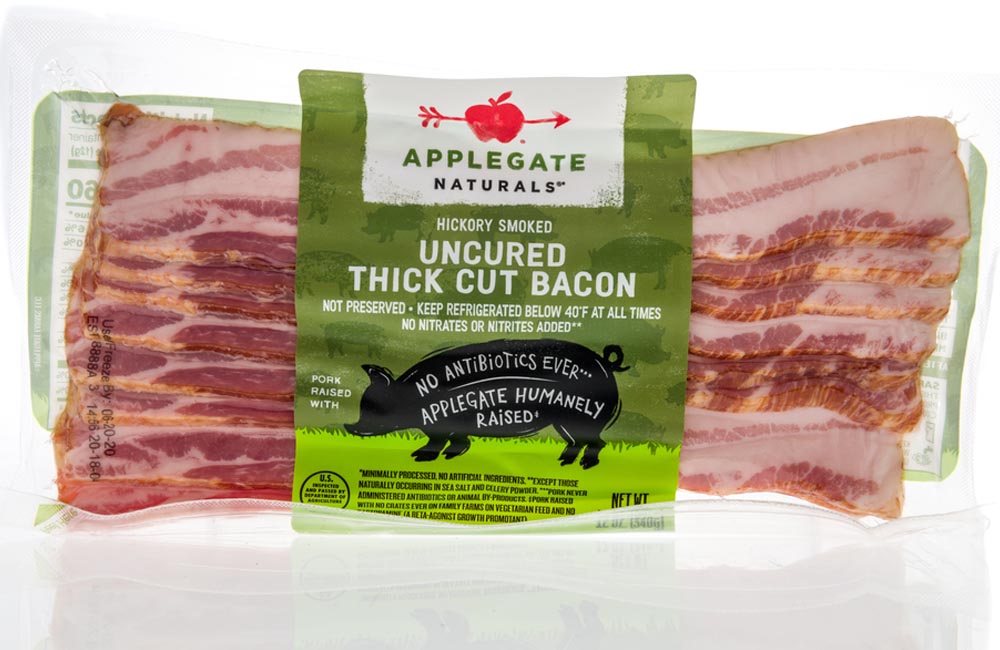 Bacon ©Keith Homan / Shutterstock.com
Bacon ©Keith Homan / Shutterstock.comIf you’re eating bacon and eggs, you’re getting a double dose. Bacon is also rich in saturated fat, which means that it can raise cholesterol levels that way, too. The serving size of bacon is small, but it’s not advised that you pile it on every day. Sadly.
69. Granola Bar
Company: Quaker, Nature Valley, Kind, etc.
Market Share: $5.75 billion by 2029*
Ingredient: Sugar
Reaching for a granola bar is often considered a healthy snack. After all, it’s not like you’re reaching for a donut, right? Well, you’d be surprised at how much sugar is in a granola bar—in some cases, you’d be better off chowing down into an éclair.
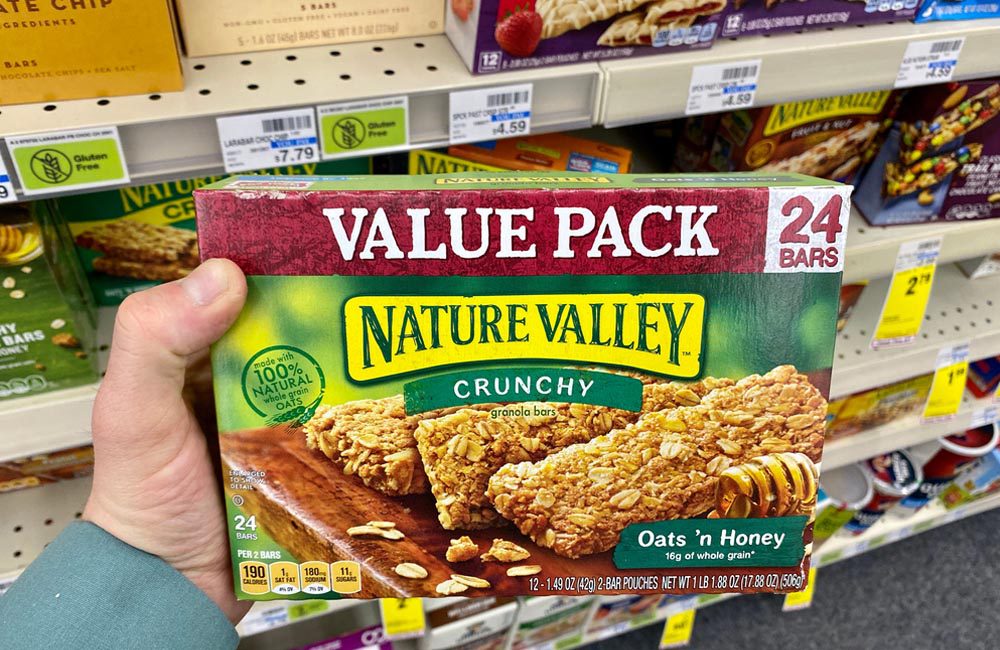 Granola Bar ©ZikG / Shutterstock.com
Granola Bar ©ZikG / Shutterstock.comThough granola bars are thought of as a safe snack, they often are high in sugar. Dieticians listed the worst granola bars to eat, according to Eat This Not That. Their no-no list includes fan-favorites like Nutri-Grain Strawberry Bars, Chocolate Brownie Cliff Bars, Quaker Chewy Dips Peanut Butter, Kashi Honey Almond Flax, and Atkins Chocolate Crisp Bars. Though the packaging might look okay, skip these bars—they’re not doing you any favors. And, as always, check the back of the box before buying.
70. Instant Ramen
Company: Top Ramen, Maruchan, and more
Market Share: $34.22 billion*
Ingredient: MSG, TBHQ, sodium
Say it ain’t so. Every broke college kid’s favorite luxury meal has been deemed unhealthy, according to Healthline. To be fair, the $0.99 price probably should have given us some hints that these noodles were packed full of preservatives. Also, the fact that the noodles come in a hard brick could also be construed as a warning sign.
 Instant Ramen ©oasisamuel / Shutterstock.com
Instant Ramen ©oasisamuel / Shutterstock.comInstant ramen noodles have their high points, in addition to being cheap and easy. They have iron, manganese, and B vitamins. Sadly, they also had MSG, high sodium, and TBHQ, three ingredients and preservatives that can negatively affect your health, possibly leading to stomach cancer, metabolic syndrome, and an increased risk of heart problems.
71. Ketchup
Company: Heinz and others
Market Share: 60% market share in U.S. for Heinz*
Ingredient: High fructose corn syrup
Sorry, but we also have to ruin ketchup for you. Ketchup-lovers won’t like this one, as it will probably put a dent in how they view their favorite condiment. Though a line (or two or three) of ketchup is a great addition to a hot dog or hamburger, watch how much you’re eating.
 Ketchup ©DenisMArt / Shutterstock.com
Ketchup ©DenisMArt / Shutterstock.comDunking fries in ketchup means you’re dunking them in high fructose corn syrup. Ketchup’s main ingredient is the toxic, unhealthy high fructose corn syrup. HFCS has been linked to heart disease, obesity, immune system troubles, and increased blood sugar levels, among other things. The bottom line: keep the fry-dunking to a minimum.
72. Flavored Nuts
Company: Planters and more
Market Share: $54.11 billion global nut market size*
Ingredient: Acrylamide
Raw nuts provide quite a few health benefits. Healthy snack nuts, like a bag of raw almonds or peanuts, are a good way to keep blood sugar level, and they’re far superior to a sugary granola bar or a handful of chips. However, flavored nuts, like honey-roasted, chocolate-powder-dipped, or chili-lime, are a different story. Though flavor adds a spark to this snack, it also adds sugar and salt.
 Flavored Nuts ©Edgar Lee Espe / Shutterstock.com
Flavored Nuts ©Edgar Lee Espe / Shutterstock.comCheck the back of the package to see which it’s higher in. If you’re looking to play it safe when it comes to sugar and sodium, buy unsalted peanuts or raw almonds. Though roasted nuts have their benefits, even roasting them can be a problem, as they can decrease the nuts’ healthy fat and lead to the formation of acrylamide, a harmful ingredient the NTP classified as a potential “human carcinogen.”
73. Dried Fruit
Company: Good and Gather, Bare, Sunsweet, and more
Market Share: $10.22 billion*
Ingredient: Sugar
Dried fruit is super expensive, so your wallet will probably thank you for axing this food from your snack list. Dried fruit is more expensive than regular fruit because of the labor that goes into extracting the juice and drying it out.
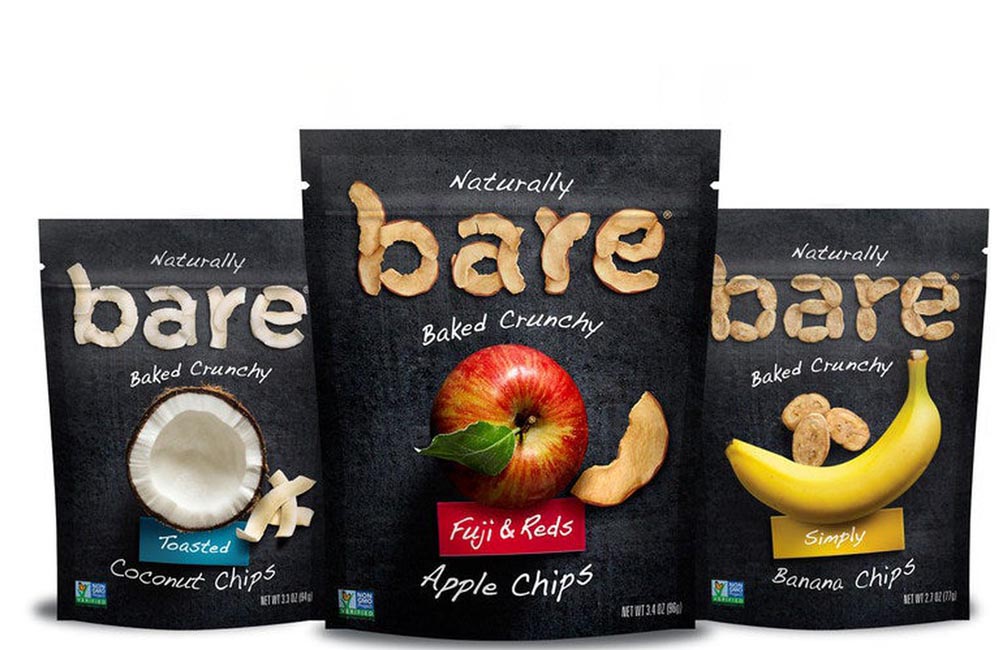 Dried Fruit @meganm71603 / Pinterest.com
Dried Fruit @meganm71603 / Pinterest.comThe problem with dried fruit is that it has a lot of sugar and calories. Because the fruit is shrunken due to the drying process, you can’t tell how much you’re eating. Though dried fruit can provide you with antioxidants and fiber, it is also jam-packed with sugar. For example, a packet of Good and Gather Dried Unsweetened Mangos has a total of 67 grams of sugar. And that’s the unsweetened kind!
74. Frozen Meals
Company: Swanson’s and more
Market Share: $55.8 billion*
Ingredient: Sodium, fat, and calories
Frozen dinners are very convenient, and it makes sense why they’re a favorite of a lot of Americans. After you come home from a long day, all you have to do is pop the meal into the microwave, wait a little bit, and then you can eat something that would have taken way longer to actually cook.
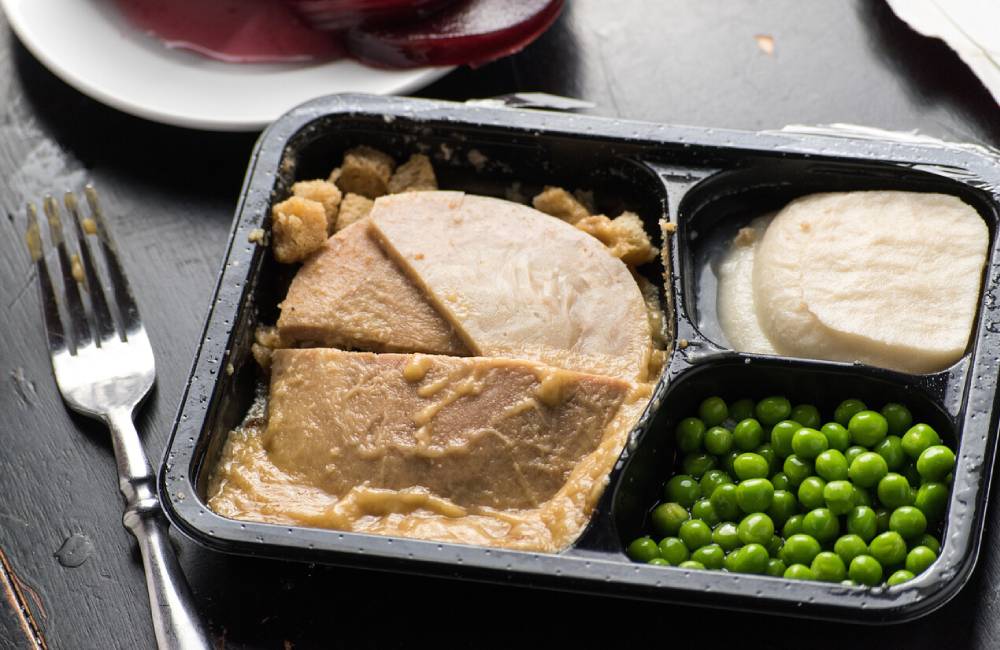 Frozen Meals ©Lynne Ann Mitchell/Adobe
Frozen Meals ©Lynne Ann Mitchell/AdobeBut, frozen dinners have their downsides. They are filled with fat, calories, and sodium—three things you want to keep in moderation. If you still want frozen meals, WebMD recommends sticking to lighter dinners from brands like Smart ones, Lean Cuisine, and Healthy Choice.
75. Wheat Bread
Company: Swanson’s and more
Market Share: $55.8 billion*
Ingredient: Sodium, fat, and calories
According to CNN, “wheat bread” is a food that seems healthy, but, in reality, most diet experts “avoid” eating it. Mark Sherwood, the founder of Tulsa’s Functional Medical Institute and the author of Quest for Wellness, called wheat bread an “ultimate con” and “deceiver.”
 Wheat Bread ©Chatham172/Shutterstock.com
Wheat Bread ©Chatham172/Shutterstock.comWhile it does have its benefits, wheat bread has a glycemic index of sixty-nine. This can cause “extreme blood sugar elevations,” which, in turn, results in a “high insulin response.” High insulin responses lead to fat accumulation and inflammation over time. Nutritionists at Healthline say that the best bread to eat is actually “sprouted whole grain.”
76. Trail Mix
Company: Archer Farms, Nature’s Garden, Market Pantry, Planters, Kirkland, and more
Market Share: $11.18 billion growth by 2026*
Ingredient: Hidden sugar
In this case, how healthy your trail mix is depends on what is in it. Trail mix has a reputation for being healthy, as it is seen as a snack you can take on-the-go when you’re out hiking. In reality, you might want to check the back of the label.
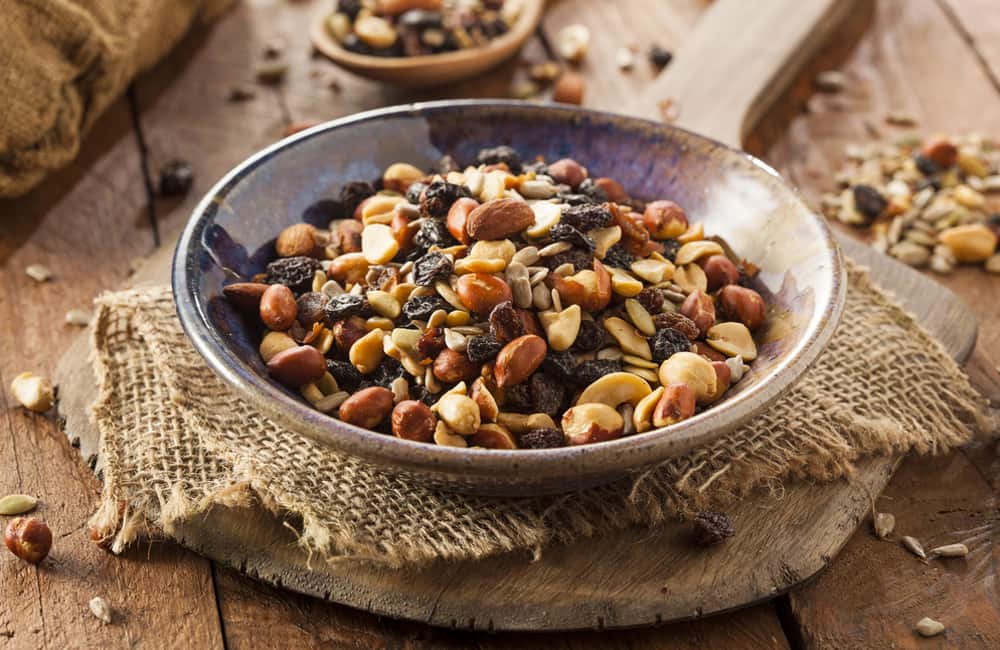 Trail Mix ©Brent Hofacker/Shutterstock.com
Trail Mix ©Brent Hofacker/Shutterstock.comThe “Monster Mix” from Archer Farms bills itself as a trail mix, but it has sixteen grams of sugar per one-quarter-cup. That’s less than a handful. You could easily find yourself topping 100 grams of sugar in one setting. Trail mix with things like M&Ms, peanut butter candies, and chocolate chips is delicious, but it is not, by any means, a healthy food.
77. Trix Yogurt
Company: General Mills
Market Share: $7.24 billion total yogurt sales in the U.S.*
Ingredient: Sugar
You probably could have guessed this one. After all, when you open a cup of Trix yogurt, glaring, bright colors stare back at you. To General Mills’ credit, they did remove the red and blue dyes from their packaging. They’ve also cut artificial flavors and high fructose corn syrup.
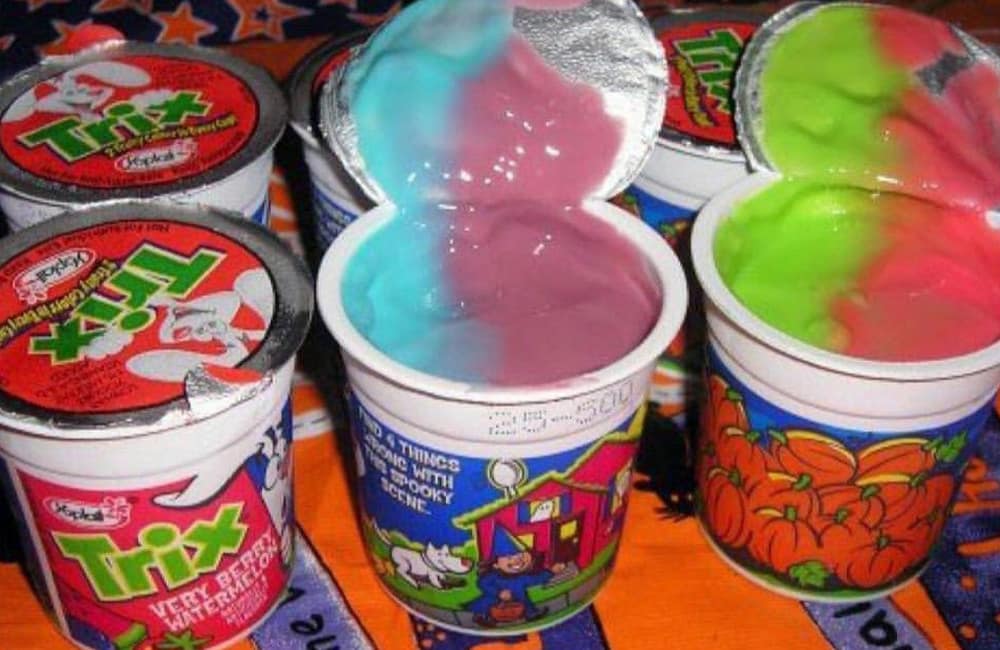 Trix Yogurt @TheKnicksWall/Twitter
Trix Yogurt @TheKnicksWall/TwitterStill, Trix has fourteen grams of sugar in just one cup of its yogurt. Though high in calcium and potassium, the sugar content is still high, especially for such a small serving size. General Mills has come a long way since the Trix’s old formulation, but it still needs improvement to make it a truly healthy food.
78. Fruit Cocktails
Company: Dole, Todays, Del Monte, Seasons, etc.
Market Share: $2.9 billion canned fruits market*
Ingredient: High fructose corn syrup
If you look at the back of the label on fruit cocktails like the Dole Canned Fruit Cocktail Salad, you’ll see, prominently listed, “High Fructose Corn Syrup.” Just because something has the word “Fruit” in it does not make it healthy, and the HFCS that fruit cocktails submerge fruit in is extremely unhealthy.
 Fruit Cocktails ©Zety Akhzar/Shutterstock.com
Fruit Cocktails ©Zety Akhzar/Shutterstock.comHFCS is even banned in several countries, including Ireland, India, Austria, Sweden, Lithuania, and Uruguay. In France, Australia, China, and the U.K., there is a limit of one pound per capita. According to the Cleveland Clinic, HFCS “increases your appetite.” Compared to regular sugar, it actually “promotes obesity more.” It contributes to high triglycerides, diabetes, inflammation, and non-alcoholic fatty liver disease as well.
79. Protein Bars
Company: Atkins, Kashi, Quest, and more
Market Share: $3.4 billion*
Ingredient: Sugar alcohols, soy, HFCS, or sugar
According to Vita Cost, there are some ingredients you will want to avoid when picking out a protein bar. These bars can be a great, healthy way to quench your appetite, as long as they don’t have any harmful ingredients lurking in their midst.
 Protein Bars @Supplementkingbridgewater/Facebook
Protein Bars @Supplementkingbridgewater/FacebookSugar alcohols and soy are two common protein bar ingredients. Xylitol, mannitol, sorbitol, and others can cause constipation, diarrhea, and intestinal pain. Soy, another ingredient, can be an allergen for sensitive consumers. And, of course, high fructose corn syrup and high quantities of sugar should also be avoided. When selecting a protein bar, keep it as simple as possible: go for bars with the fewest artificial ingredients.
80. Frozen Yogurt
Company: Yasso, Stonyfield, Friendly’s, Ben & Jerry’s, etc.
Market Share: $2.14 billion by 2028*
Ingredient: Sugar
Be careful hanging your hat on frozen yogurt as a healthy dessert. Though frozen yogurt has some health benefits, such as lower calories and lower fat and saturated fat, as well as beneficial bacteria and nutrients, it isn’t a food you should binge on or even eat that frequently.
 Frozen Yogurt ©alisafarov/Shutterstock.com
Frozen Yogurt ©alisafarov/Shutterstock.comFor example, Friendly’s Frozen Yogurt has eighteen grams of sugar in just one half-cup serving. It also has no Vitamin A, no Vitamin C, and no iron, as well as just 10% the DV of calcium. Treat frozen yogurt like ice cream, and only eat it in moderation, as this “health food” is full of hidden sugar.
81. Anything Artificially Bright Orange
Company: Various
Market Share: $74.7 million market size for yellow dye*
Ingredient: Yellow Dye #5 and #6
Really, any food that is a color you wouldn’t see in nature is probably not good for you. No, we’re not talking about regular oranges. Bright orange food, such as SunnyD, dyed cereals, popsicles, and candy, likely didn’t get that way naturally. The dyes used to create that orange color can be deadly.
 Anything Bright Orange @SunnyD/Facebook
Anything Bright Orange @SunnyD/FacebookFor example, according to the back of the SunnyD ingredient list, the company uses two Yellow Dyes, #5 and #6, to create the drink’s classic, fluorescent-orange color. According to Healthline, these dyes, along with Red #40, “may contain contaminants” known to cause cancer. In Norway and Finland, these Yellows are both banned.
82. Green Potatoes
Company: N/A
Market Share: N/A
Ingredient: Solanine
If you have potatoes that have greened, don’t try to cook with them—avoid using green potatoes in any recipe, and just throw the tubers away. According to the New York Times, green potatoes have high levels of solanine, a toxin. Solanine is known to cause neurological problems, headaches, and nausea.
 Green Potatoes ©Jerawat Suwannitipat/Shutterstock.com
Green Potatoes ©Jerawat Suwannitipat/Shutterstock.comSolanine cannot be removed just by boiling. As cooks and the public have become more aware of the dangers green potatoes pose, solanine poisoning has become less common. But, just in case there is someone reading this who thinks they can wing it with green potatoes, we say to throw them out or risk some pretty nasty side effects.
83. Veggie Omelette
Company: Restaurants, usually
Market Share: $160 billion by 2027* (Total Egg Market)
Ingredient: High amounts of cooking oil
When you go to a restaurant for breakfast or brunch, you might be tempted to order the veggie omelet as a way to eat healthy. After all, the veggie option doesn’t have ham or processed meats. Be careful ordering the veggie omelet too frequently, as restaurants often cook the vegetables used in the omelet in vegetable oil or butter.
 Veggie Omelette @eaterscollective /Unsplash.com
Veggie Omelette @eaterscollective /Unsplash.comAccording to TIME, vegetable oils have unsaturated fats that, when heated, oxide. When oxidized, these fats are dangerous to body tissues, triggering inflammation that can lead to blood vessel plaques. If these plaques grow unstable enough, they can cause a heart attack.
84. Agave Nectar
Company: Agave in the Raw, Kirkland Signature, MADHAVA, etc.
Market Share: $250 million*
Ingredient: Fructose
When it comes to sugar, one of the healthiest sources is fruit. Your body is equipped to handle fruits’ small amount of sugar (though certain fruits, like mangos, should be eaten in moderation). Also, fruit has fiber, a necessary ingredient for digestive health.
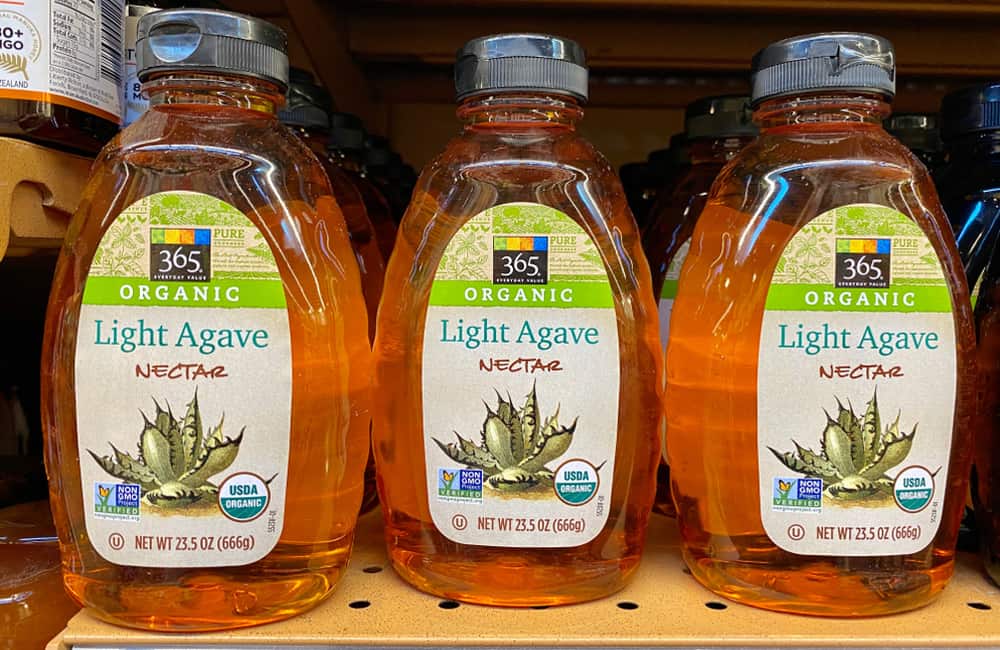 Agave Nectar ©ZikG/Shutterstock.com
Agave Nectar ©ZikG/Shutterstock.comAgave syrup has long been touted as a healthy sweetener, but it actually is not. It is higher in fructose, a ketonic simple sugar, than regular sugar. According to Healthline, this means that agave nectar has a higher “potential” of causing “adverse health effects” like fatty liver disease and increased belly fat. People who are trying to manage their blood sugar should stay away from agave.
85. Gatorade
Company: Gatorade
Market Share: $6 billion annual sales*
Ingredient: Dye, sugar
For a long time, Gatorade has billed itself as a healthy drink for athletes. While athletes prefer the sweet-tasting beverage, they should be wary of the sugar and dyes in Gatorade. A 20-ounce bottle of Thirst Quencher, for example, contains thirty-six grams of sugar.
Berkeley researchers have even said that the sugar in sports drinks could be contributing to child obesity, as they have a high caloric intake and sugar content. Additionally, dyes like Red #40, Blue #1, and Yellow #5 have all been found in Gatorade drinks. According to Medical News Today, Red #40 has been “linked” to symptoms of ADHD, including “hyperactivity.”
86. Atkins Desserts
Company: Atkins
Market Share: $2.7 billion annual revenue for Atkins*
Ingredient: Maltitol, sucralose, and other sweeteners
Atkins is a diet company focused on promoting a low-carb lifestyle. They have tons of desserts, protein bars, and shakes that promise to keep you full without sacrificing a sweet taste. Atkins achieves this sweet taste by adding in sweeteners like maltitol, a sugar alcohol, and sucralose.
 Atkins Desserts @AtkinsNutritionals/Facebook
Atkins Desserts @AtkinsNutritionals/FacebookOne example of the Atkins Endulge Chocolate Candies. In addition to a lot of dyes, these candies are sweetened with maltitol and sucralose, both of which are linked to digestive problems. While both of these ingredients are FDA approved, they have been known to cause indigestion, nausea, and abdominal discomfort among people who are sensitive to them.
87. Hot Dogs
Company: Restaurants, Applegate Farms, Oscar Meyer, Hebrew National, and more
Market Share: $23.29 billion*
Ingredient: Nitrates and other preservatives
TIME did an expose on “What Hot Dogs Do To The Body,” and the results were chilling. Hot dogs are a summer food staple, whether you’re having a cookout or going to a baseball game. Though an undoubtedly iconic piece of American cuisine, hot dogs are decidedly not a favorite of nutritionists and health professionals.
 Hot Dogs ©Brent Hofacker/Shutterstock.com
Hot Dogs ©Brent Hofacker/Shutterstock.comHot dogs are heavily processed, and TIME reported that people who ate more processed meats had a higher risk of bladder cancer and Type 2 diabetes than people who ate little to no processed meat. The nitrate preservatives added to give hot dogs a longer shelf life have also been linked to cancer in mammals.
88. Pickles
Company: Mt. Olive, Vlasic, Heinz, Park Street Deli, etc.
Market Share: $11.1 billion*
Ingredient: Sodium
We all know someone who loves pickles, whether they’re stealing the pickle from your plate at a restaurant or buying them by the jar. While pickles are a great addition to any meal, they are high in sodium. In one medium pickle, there are 785 milligrams of sodium. Sodium is necessary to make pickles, as they are part of the brining process.
 Pickles ©natali_ploskaya/Shutterstock.com
Pickles ©natali_ploskaya/Shutterstock.comConsuming too much salt in your diet contributes to high blood pressure. WebMD says that high-sodium diets can even increase your risk of gastric cancer, as the salt intake can lead to stomach infections and ulcers that later turn malignant.
89. Maple Syrup
Company: 365 by Whole Foods, Mrs. Butterworth’s, Log Cabin, Aunt Jemima, etc.
Market Share: $1.24 billion*
Ingredient: Sugar
Pure maple syrup is completely natural, and it has no artificial flavorings, colorings, or additives. That’s why it is important to always put it back in the fridge after you use it, lest it grow harmful bacteria and mold.
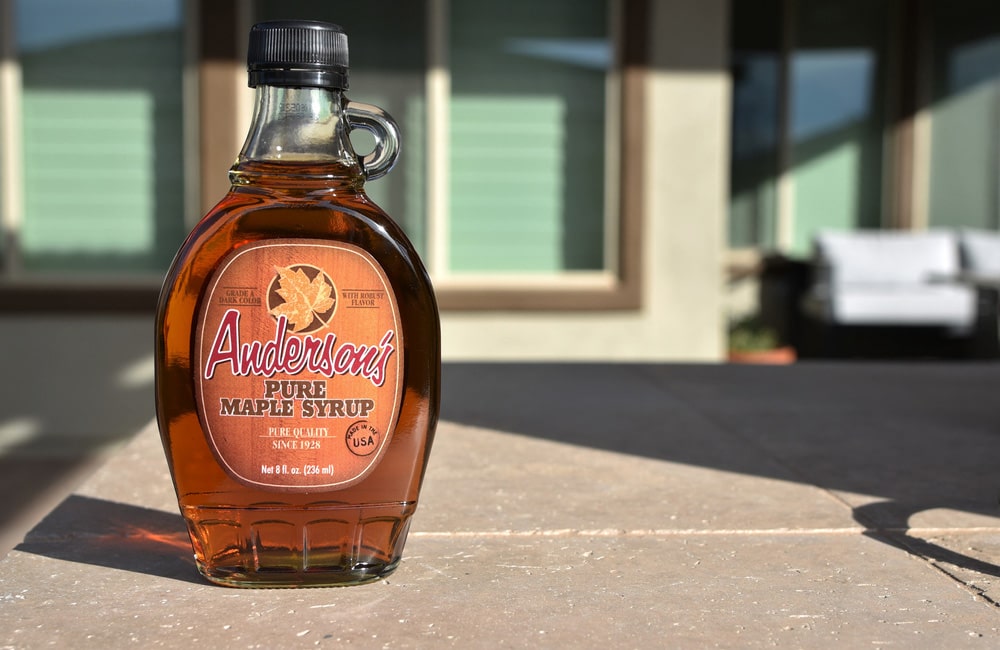 Maple Syrup ©Thomas Trompeter/Shutterstock.com
Maple Syrup ©Thomas Trompeter/Shutterstock.comWebMD cautions against ingesting too much maple syrup (i.e. eating a stack of pancakes and French toast every morning), as it is high in sugar. Ingesting maple syrup, because it contains sugar and no fiber, can lead to swings in your blood sugar and insulin levels. Healthline says that, “calorie for calorie,” this syrup is a bad choice of nutrients when compared to more whole foods like fruits, vegetables, and unprocessed animal foods.
